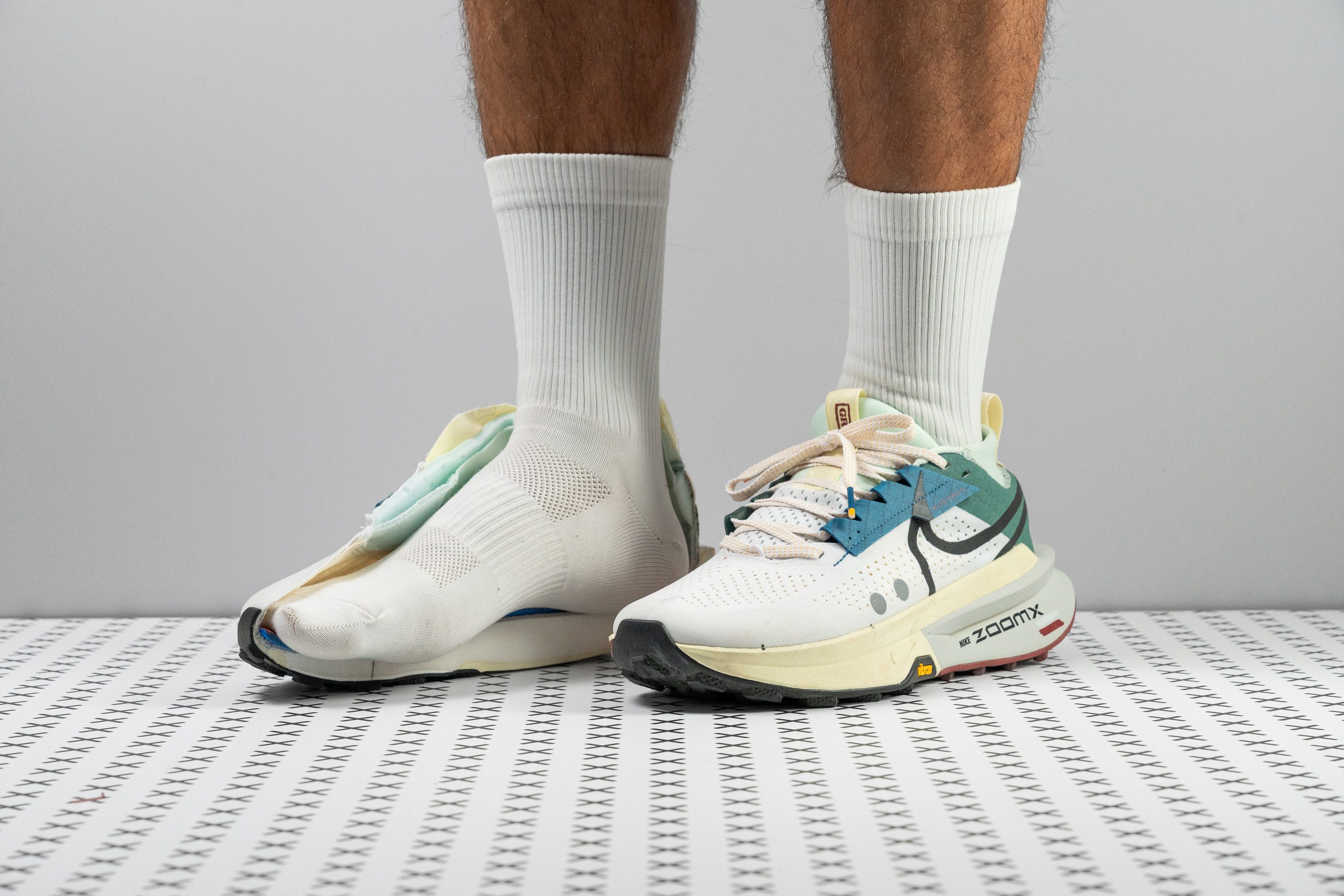Our verdict
- Top pick in best trail running shoes
- Top pick in best Nike trail running shoes
Pros
- More ZoomX bouncy foam!
- Vibram Megagrip outsole
- Spacious upper
- Exceptional durability
- Superb wet condition traction
- Ideal for midfoot and forefoot strikers
- Ready for long-distance running
- Suitable for hiking too
Cons
- Could be lighter
- Not ideal for heel strikers
- Limited toebox vertical space
Audience verdict
- Top 27% most popular running shoes
Comparison
The most similar running shoes compared
+ + Add a shoe | |||||
|---|---|---|---|---|---|
| Audience score | 87 Great! | 78 Decent! | 89 Great! | 90 Superb! | |
| Price | £165 | £140 | £140 | £135 | |
| Trail terrain | Moderate | Moderate | ModerateTechnical | ModerateTechnical | |
| Shock absorption | Moderate | Moderate | Low | - | |
| Energy return | Moderate | Low | Low | - | |
| Arch support | Neutral | Neutral | Neutral | Neutral | |
| Weight lab Weight brand | 10.7 oz / 302g 10.7 oz / 303g | 9.8 oz / 278g 9.8 oz / 277g | 9.6 oz / 271g 10.2 oz / 290g | 10.2 oz / 288g 10.1 oz / 286g | |
| Drop lab Drop brand | 4.0 mm 4.0 mm | 4.9 mm 5.0 mm | 3.0 mm 4.0 mm | 4.4 mm 3.0 mm | |
| Strike pattern | Mid/forefoot | Mid/forefoot | Mid/forefoot | Mid/forefoot | |
| Size | True to size | Slightly small | True to size | True to size | |
| Midsole softness | Soft | Balanced | Soft | Soft | |
| Difference in midsole softness in cold | Small | Small | Normal | Normal | |
| Toebox durability | Good | Good | Good | Very good | |
| Heel padding durability | Good | Good | Decent | Decent | |
| Outsole durability | Good | Decent | Good | - | |
| Breathability | Moderate | Warm | Warm | Moderate | |
| Width / fit | Medium | Medium | Medium | Medium | |
| Toebox width | Wide | Medium | Medium | Medium | |
| Stiffness | Moderate | Stiff | Moderate | Stiff | |
| Torsional rigidity | Stiff | Stiff | Stiff | Moderate | |
| Heel counter stiffness | Flexible | Moderate | Flexible | Moderate | |
| Lug depth | 4.0 mm | 4.0 mm | 4.0 mm | 4.4 mm | |
| Heel stack lab Heel stack brand | 30.3 mm 36.0 mm | 32.1 mm 40.0 mm | 27.6 mm 31.0 mm | 30.1 mm 31.0 mm | |
| Forefoot lab Forefoot brand | 26.3 mm 32.0 mm | 27.2 mm 35.0 mm | 24.6 mm 27.0 mm | 25.7 mm 28.0 mm | |
| Widths available | Normal | NormalWide | Normal | Normal | |
| For heavy runners | ✗ | ✓ | ✗ | ✗ | |
| Season | All seasons | All seasons | Winter | All seasons | |
| Removable insole | ✓ | ✓ | ✓ | ✓ | |
| Orthotic friendly | ✓ | ✓ | ✓ | ✓ | |
| Ranking | #145 Top 39% | #332 Bottom 11% | #97 Top 26% | #37 Top 10% | |
| Popularity | #98 Top 27% | #53 Top 15% | #221 Bottom 40% | #301 Bottom 19% |
Who should buy
We consider the Zegama 2 an outstanding pick for runners who enjoy the plush comfort of ZoomX in Nike road shoes but are in the market for a trail-specific option. Therefore, we recommend it for:
- Runners seeking a cushioned, premium experience on trails, mirroring the comfort of their favourite road shoes.
- Those in need of a reliable trail workhorse capable of effortlessly tackling easy to moderate trails, providing excellent durability and grip.
- Casual trail runners who prioritise comfort and support during their outdoor adventures and don't mind a high price tag.
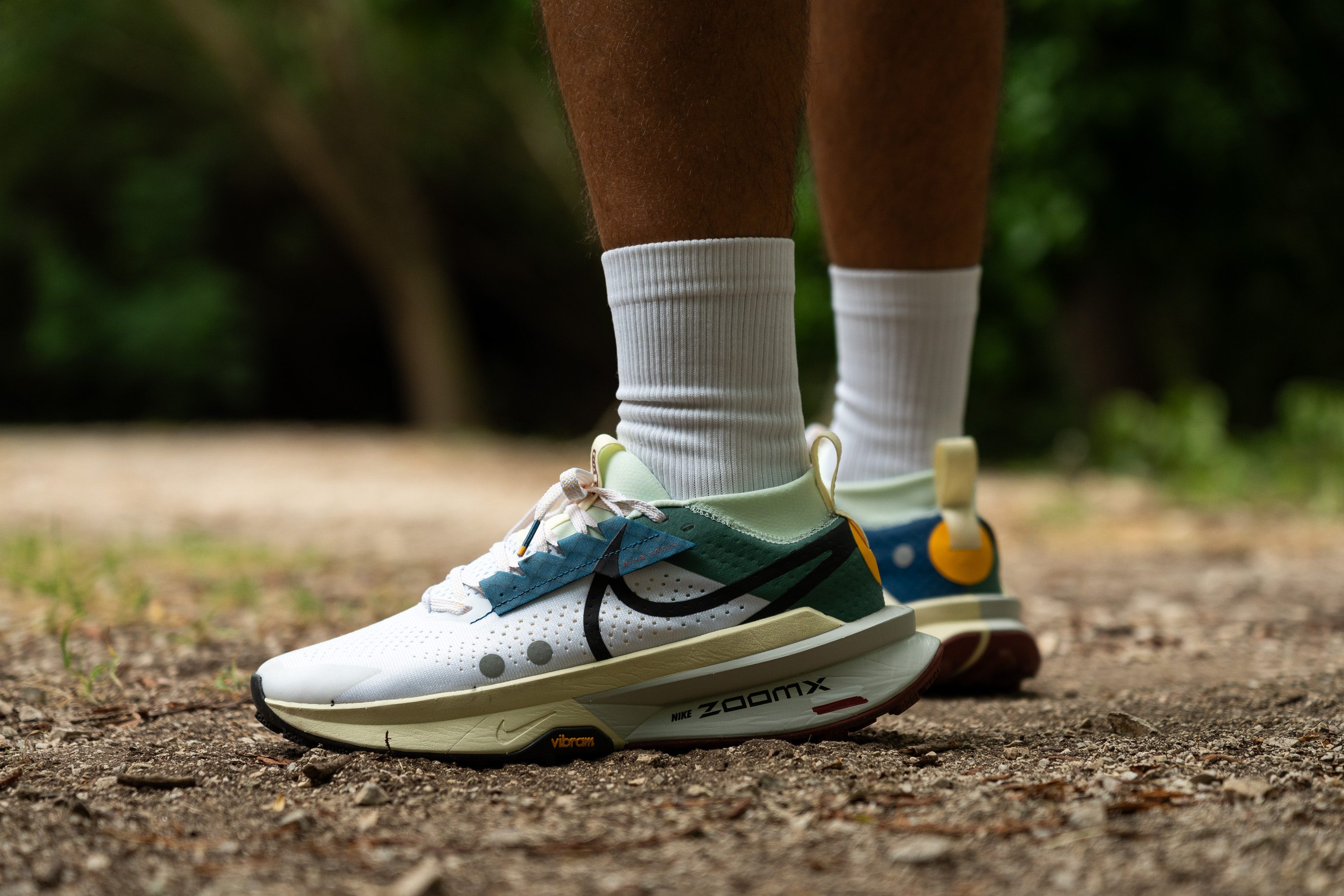
Who should NOT buy
While the Zegama 2 boasts several upgrades, its weight is still a downside. We are convinced that those in search of a lighter trail shoe should consider alternatives like the Hoka Speedgoat 5 or the Saucony Peregrine 14.
Despite its inclusion of ZoomX foam, we've also concluded that the Zegama 2 falls short for competitive racing in the mountains. Fortunately, Nike's Ultrafly stands out as a superior choice for trail races—offering raw speed and a carbon plate. As an alternative to Nike, we suggest the Hoka Tecton X 2, which is a lighter and more agile option.
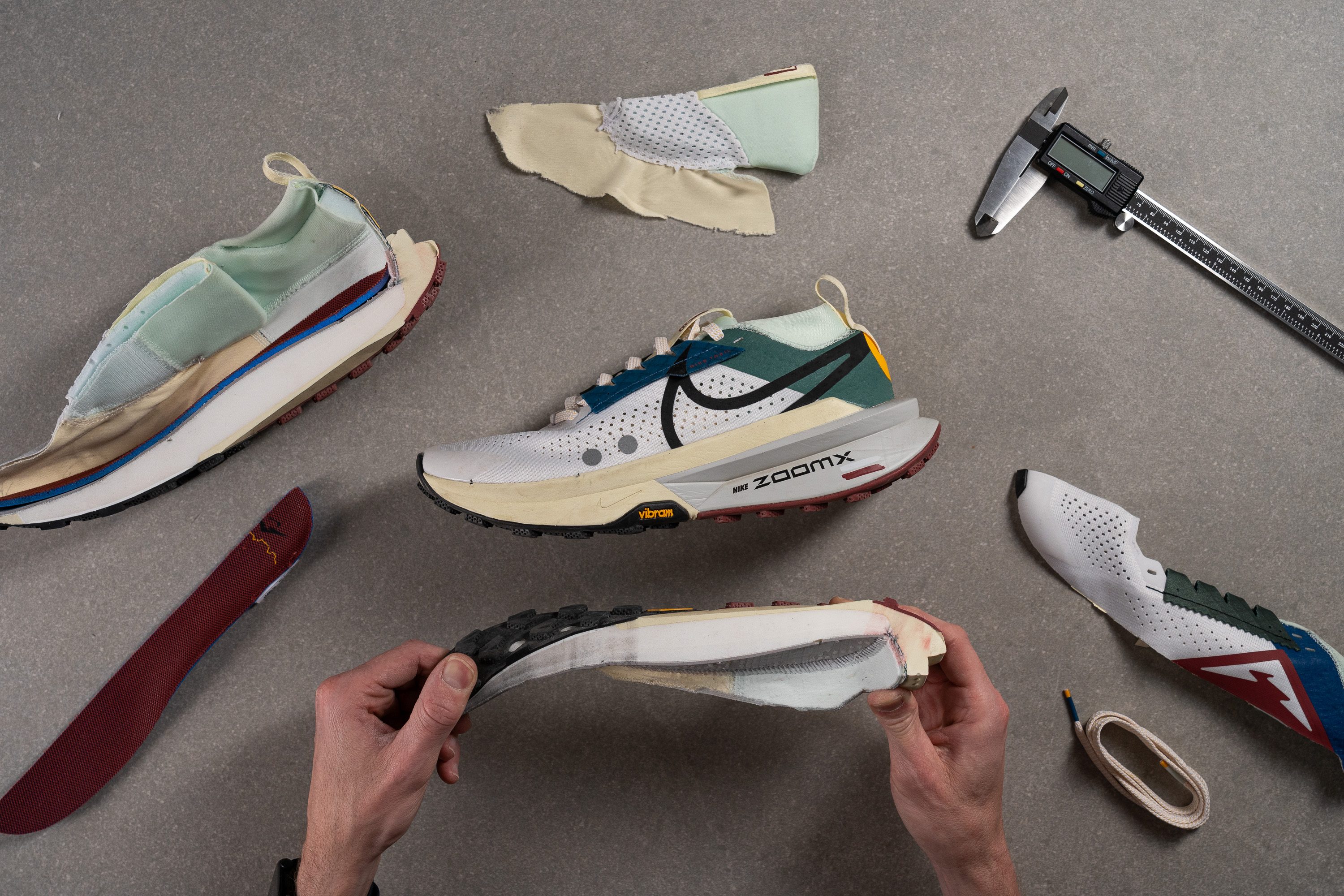
Cushioning
Shock absorption
One of the key advantages of using Pebax over EVA is its ability to deliver more shock absorption with the same amount of foam. That’s why, even without a maximalist midsole, the Zegama 2 reached an impressive 130 SA in our lab test.

| Zegama 2 | 130 SA |
| Average | 122 SA |
Energy return
It’s great to see more ZoomX foam in the Zegama 2, as it brings better energy return.
We confirmed that in the lab: it reached 60.2% in the heel due to the limited amount of premium foam, but soared to a fantastic 68.9% in the forefoot.
| Zegama 2 | 60.2% |
| Average | 55.6% |
Heel stack
The Zegama 2 features a heel stack height of 30.3 mm, which is less than stated by the brand. This perception also arises because the shoe has prominent midsole sidewalls that create an illusion of greater height, and the midfoot is slightly elevated compared to the heel—a design trend also seen in recent models like the New Balance FuelCell Rebel v4.
Does this shoe need more cushioning? It varies by runner, but for most trail enthusiasts, just over 30 mm should suffice, particularly given the leg-saving properties of the ZoomX foam. And for those who want a towering trail shoe we recommend the maximalist New Balance Fresh Foam X More Trail v3 (38.6 mm).
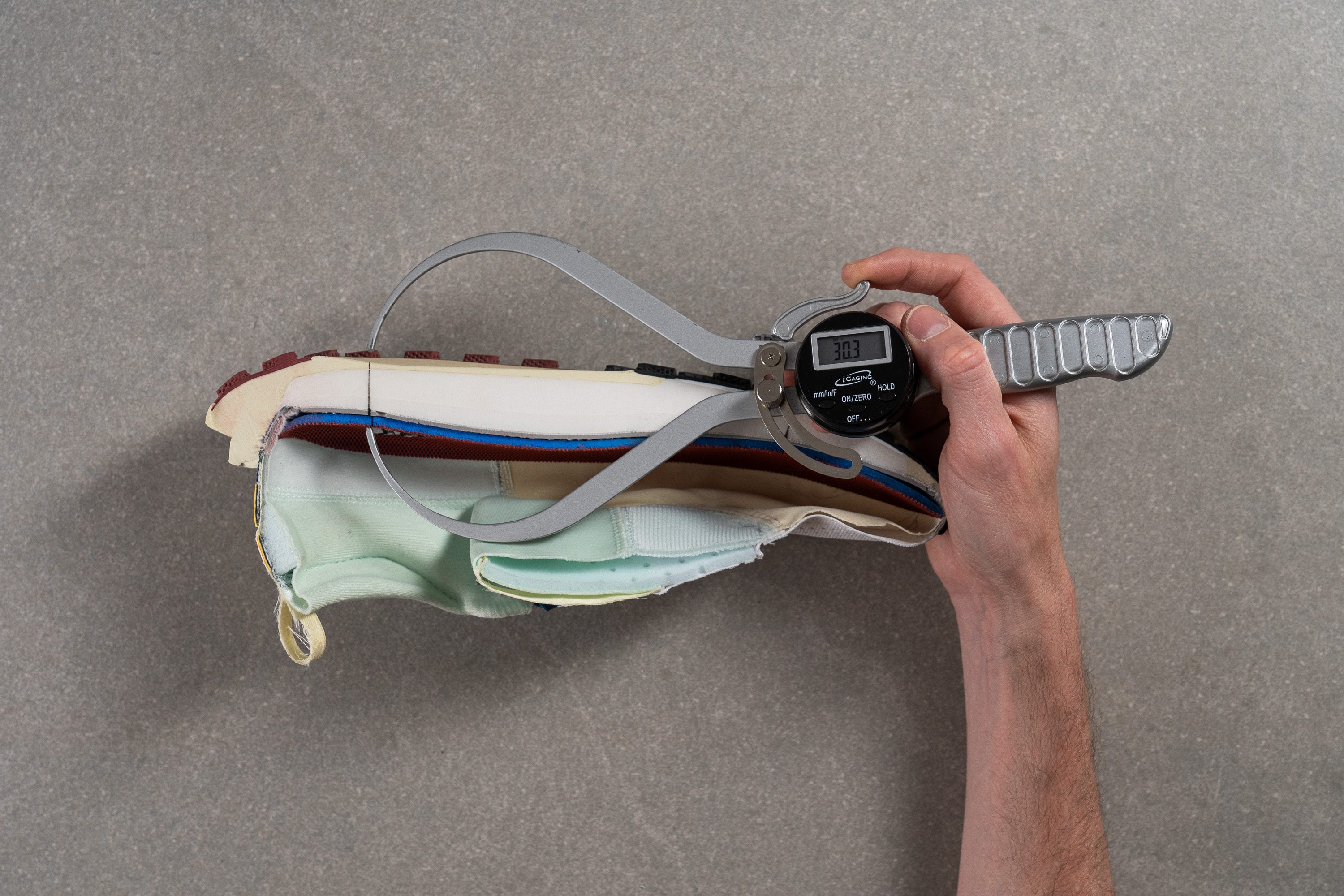
| Zegama 2 | 30.3 mm |
| Average | 32.6 mm |
Forefoot stack
Our digital callipers clocked the forefoot of the Zegama 2 at 26.3 mm.
While this figure doesn't place it in the maximalist category for us, we acknowledge that it's definitely more cushioned than many other trail shoes, making it a good pick for both forefoot and midfoot strikers.
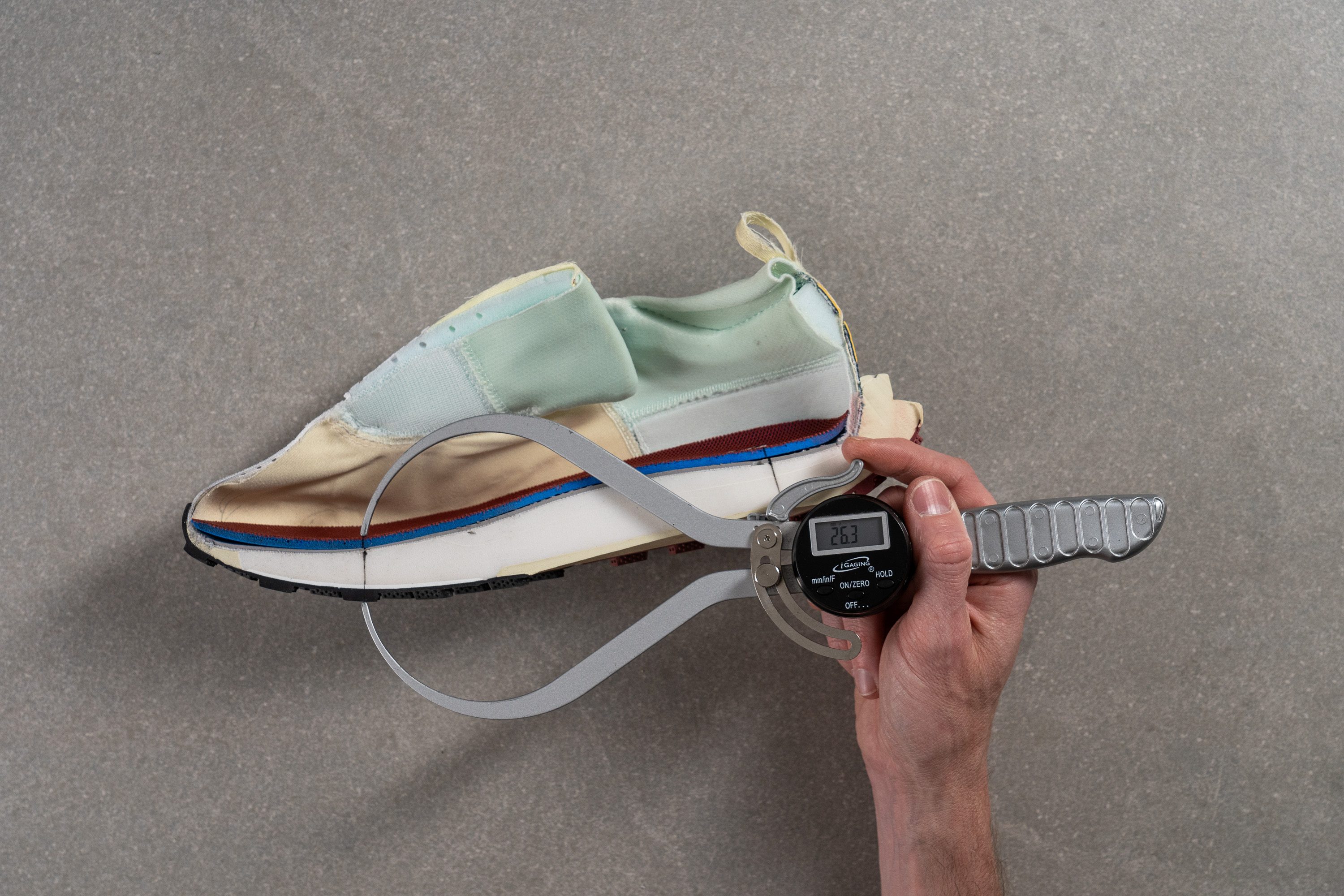
| Zegama 2 | 26.3 mm |
| Average | 25.1 mm |
Drop
Nike claims the Zegama 2 has a 4.0 mm offset, and our measurements confirmed exactly that. This accuracy is quite exceptional, as often brand claims don't align with our findings, so credit to Nike for their precision on this aspect.
While a 4-mm drop might appear on the lower end, it's actually optimal for most trail shoes. Lower drops enhance control on downhill sections and boost stability, making them ideal for varied terrain.
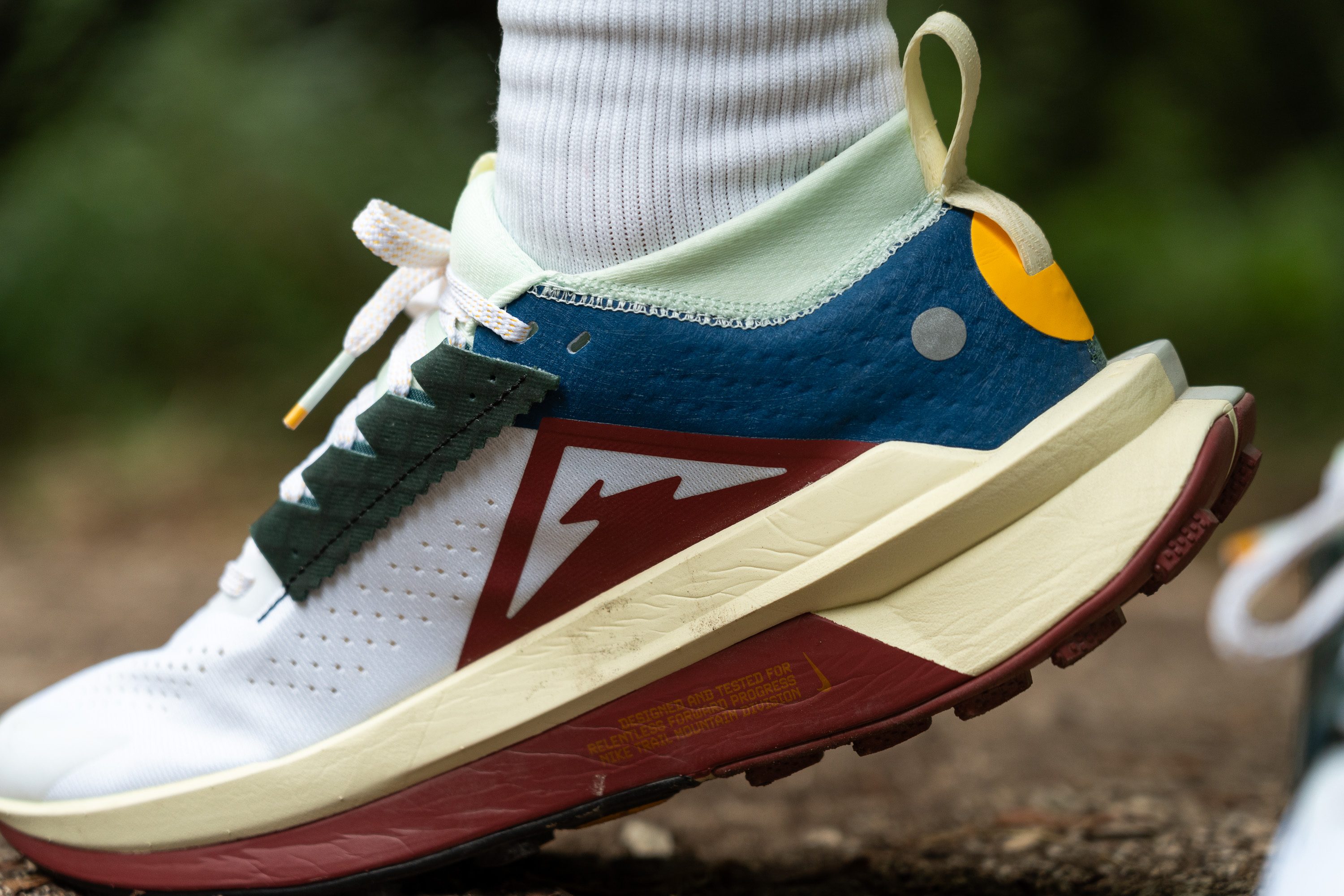
| Zegama 2 | 4.0 mm |
| Average | 7.5 mm |
Midsole softness
We've finally reached the highlight of the Zegama 2—the reason it was created: the ZoomX foam. Even though "ZoomX" is no longer in the name, this shoe now contains even more of this superb, bouncy Pebax-based foam.
Using a Shore A durometer, we determined it falls on the plush end of the spectrum at just 14.5 HA. This translates into a soft ride, though there is a small caveat to consider...
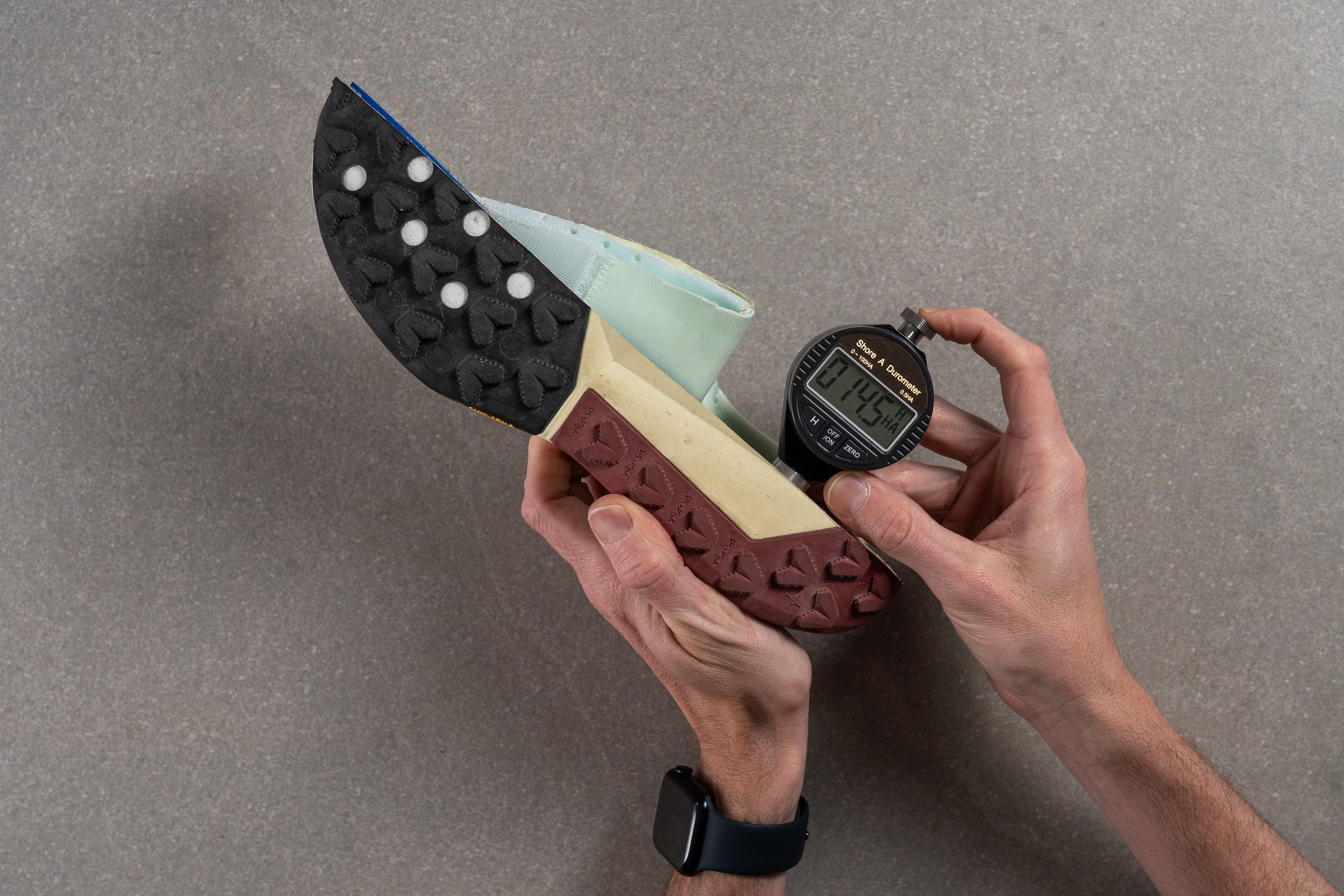
| Zegama 2 | 14.5 HA |
| Average | 21.9 HA |
Secondary foam softness
Like its predecessor, the Zegama 2 features a dual-foam midsole with a main layer of ZoomX superfoam topped by a thin EVA carrier foam (SR-02). The purpose of SR-02 is mainly to enhance durability by shielding the more delicate ZoomX from the ground.

Nike has refined the SR-02 (14.0 HA) to closely match the softness of ZoomX, providing a similarly plush feel, albeit with way less energy return. Thankfully, it's far from the rock-hard carrier foams found in some other shoes.

| Zegama 2 | 14.0 HA |
| Average | 25.3 HA |
Rocker
The updated rocker geometry significantly enhances the ride, making it much more dynamic. Combined with the softer ZoomX-based midsole, we found the rocker optimises the transition from midfoot to forefoot, which is much needed in a shoe that's well over 10 ounces.
Size and fit
Size
Nike Zegama 2 fits true to size (160 votes).
Width / Fit
We're incredibly pleased because, just as with the Pegasus 41, Nike continues to produce roomier shoes in recent years, a delightful change from the traditionally snug toeboxes. And the Zegama 2 is no exception.
We created a gel mould of the shoe's interiors, and the widest part measured 97.5 mm—slightly wider than most trail shoes.
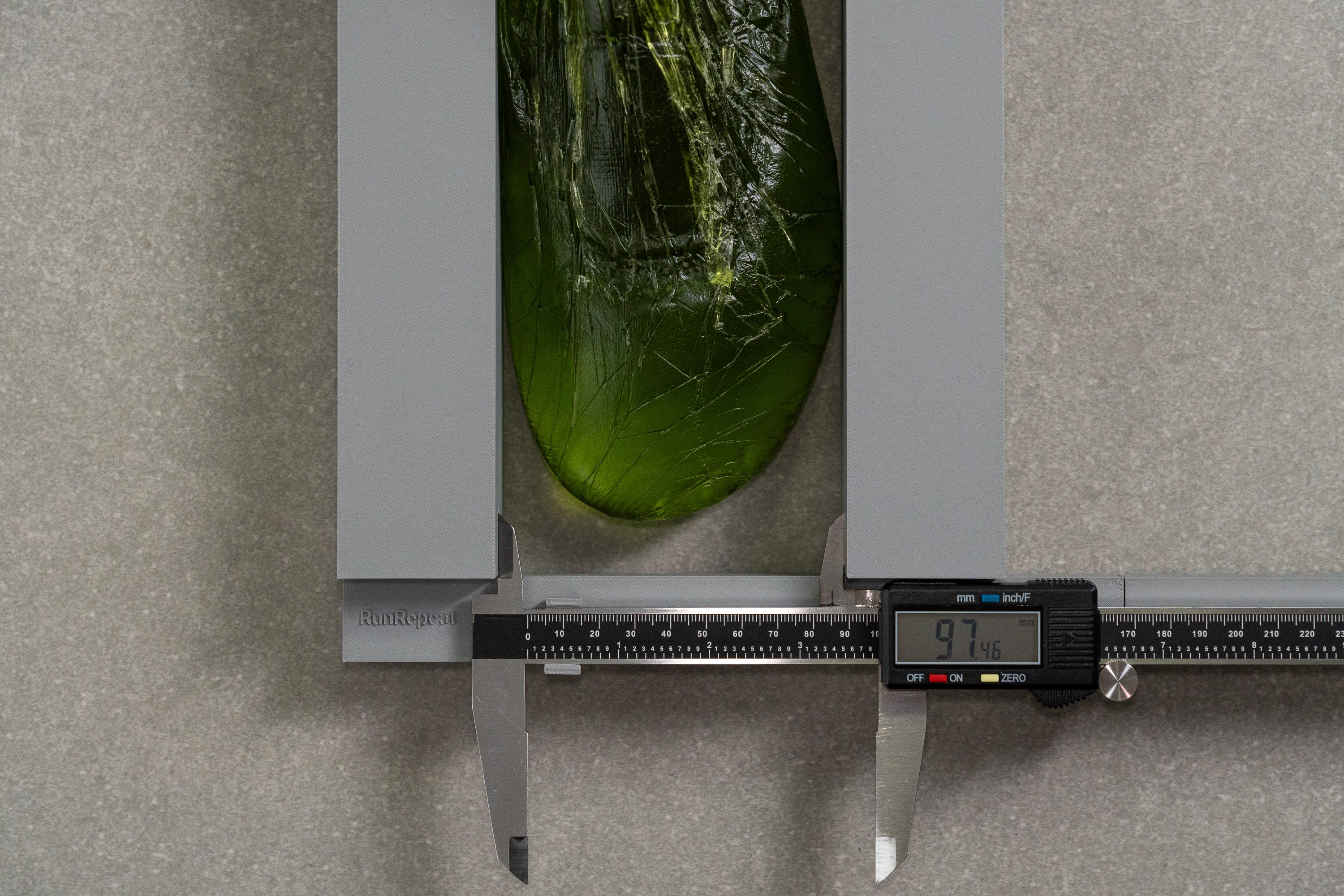
| Zegama 2 | 97.5 mm |
| Average | 95.6 mm |
Toebox width
Our second measurement in the big toe area confirmed the toebox’s generous width at 76.4 mm. Once again, the Zegama 2 surpasses the average trail shoe.
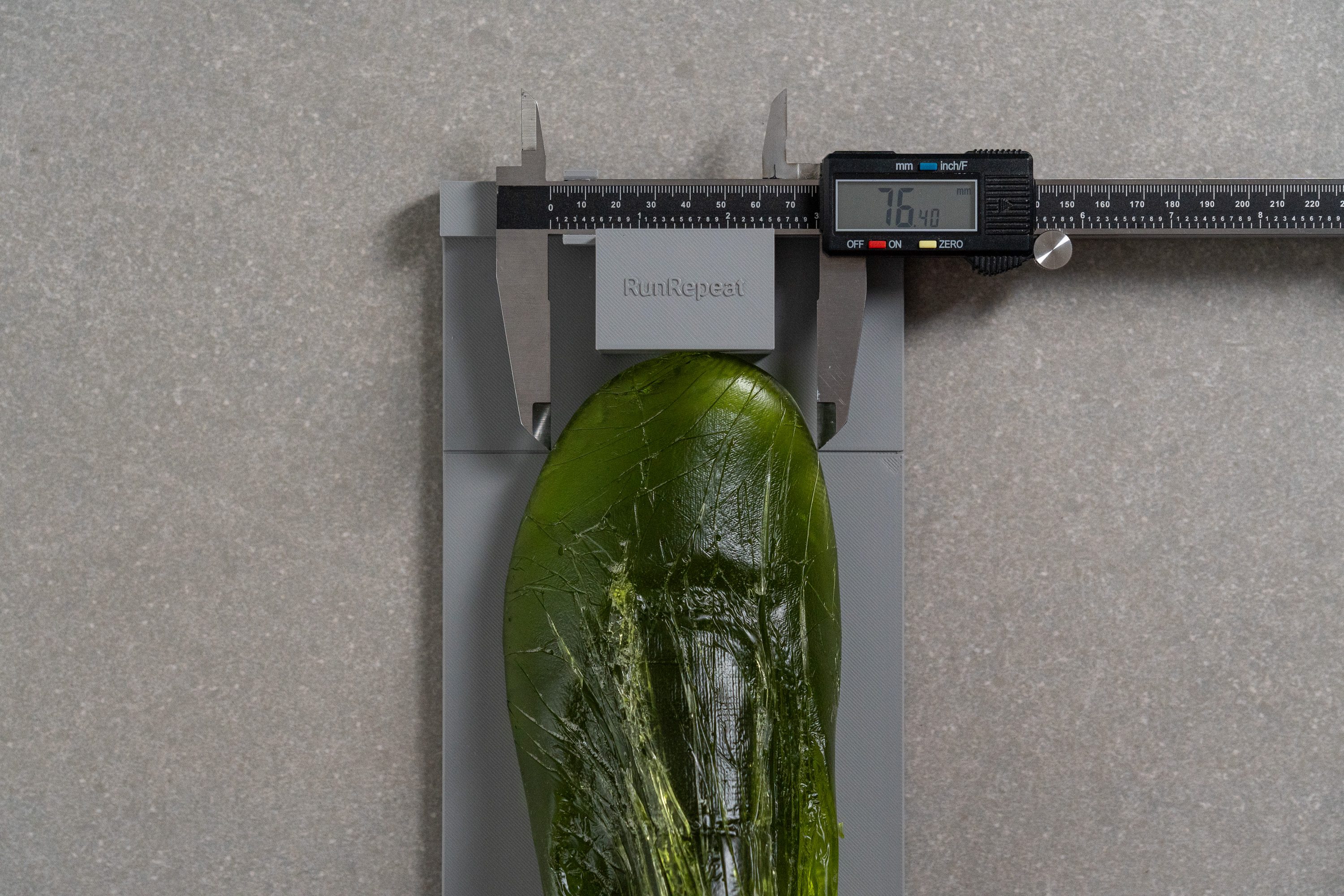
| Zegama 2 | 76.4 mm |
| Average | 74.6 mm |
Toebox height
In terms of height, the Zegama offers decent volume at 27.4 mm, but we must warn that the material lacks flexibility, so what you see is what you get.
Moving your toes upward won’t create any extra room.
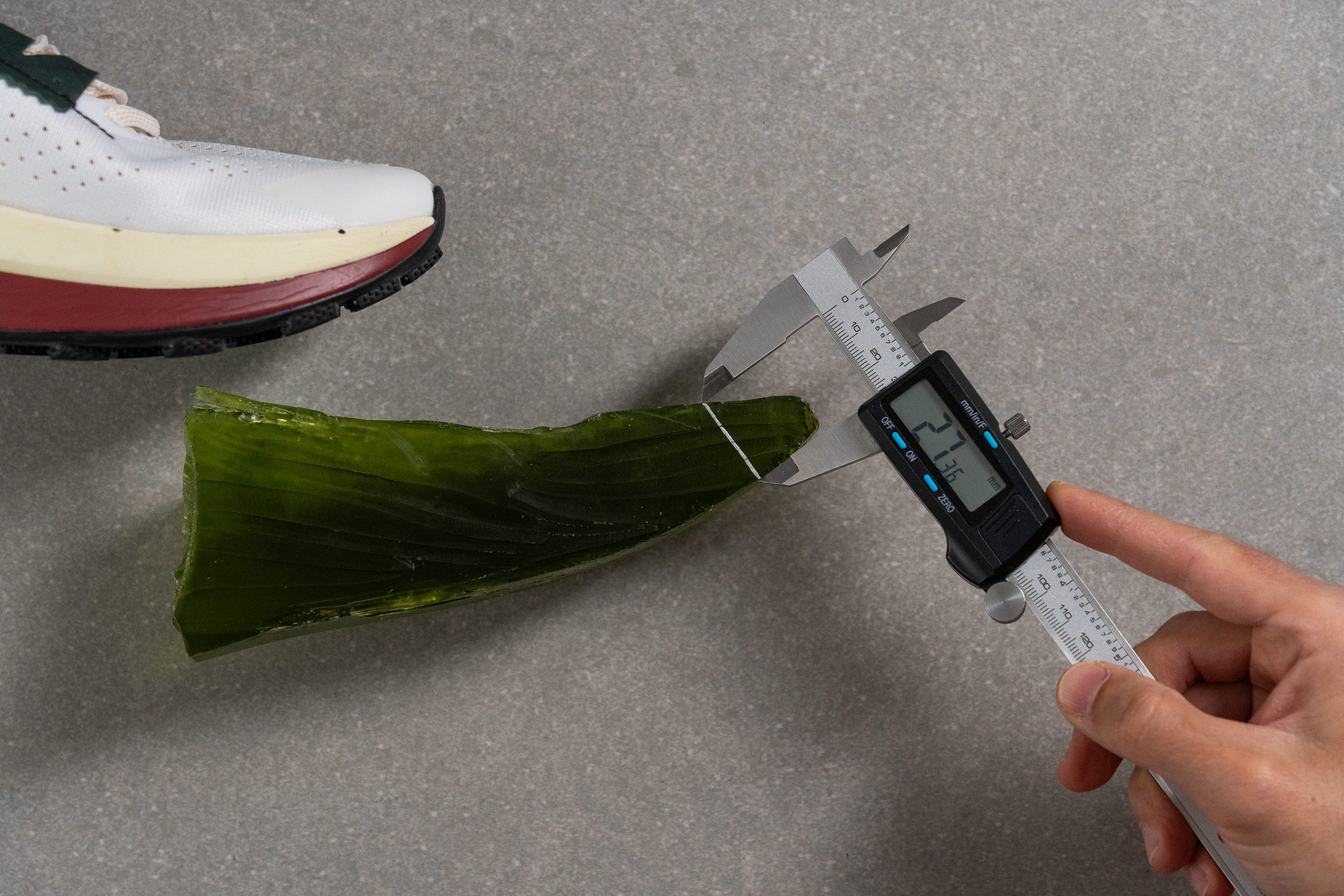
| Zegama 2 | 27.4 mm |
| Average | 27.1 mm |
Traction / Grip
Forefoot traction
Switching to Vibram rubber truly elevated the Zegama, as we measured an impressive 0.54 in our wet-grip test. That’s a standout result for a trail shoe, solidifying its status as Nike’s premium mountain-ready model.
| Zegama 2 | |
| Average | 0.61 |
Lug depth
Returning to the outsole, we discovered that Nike partnered with Italian-based Vibram to equip the Zegama 2 with a Megagrip outsole featuring 4.0-mm deep lugs.
This design is quite standard, performing well across various conditions without specialising in any one area.
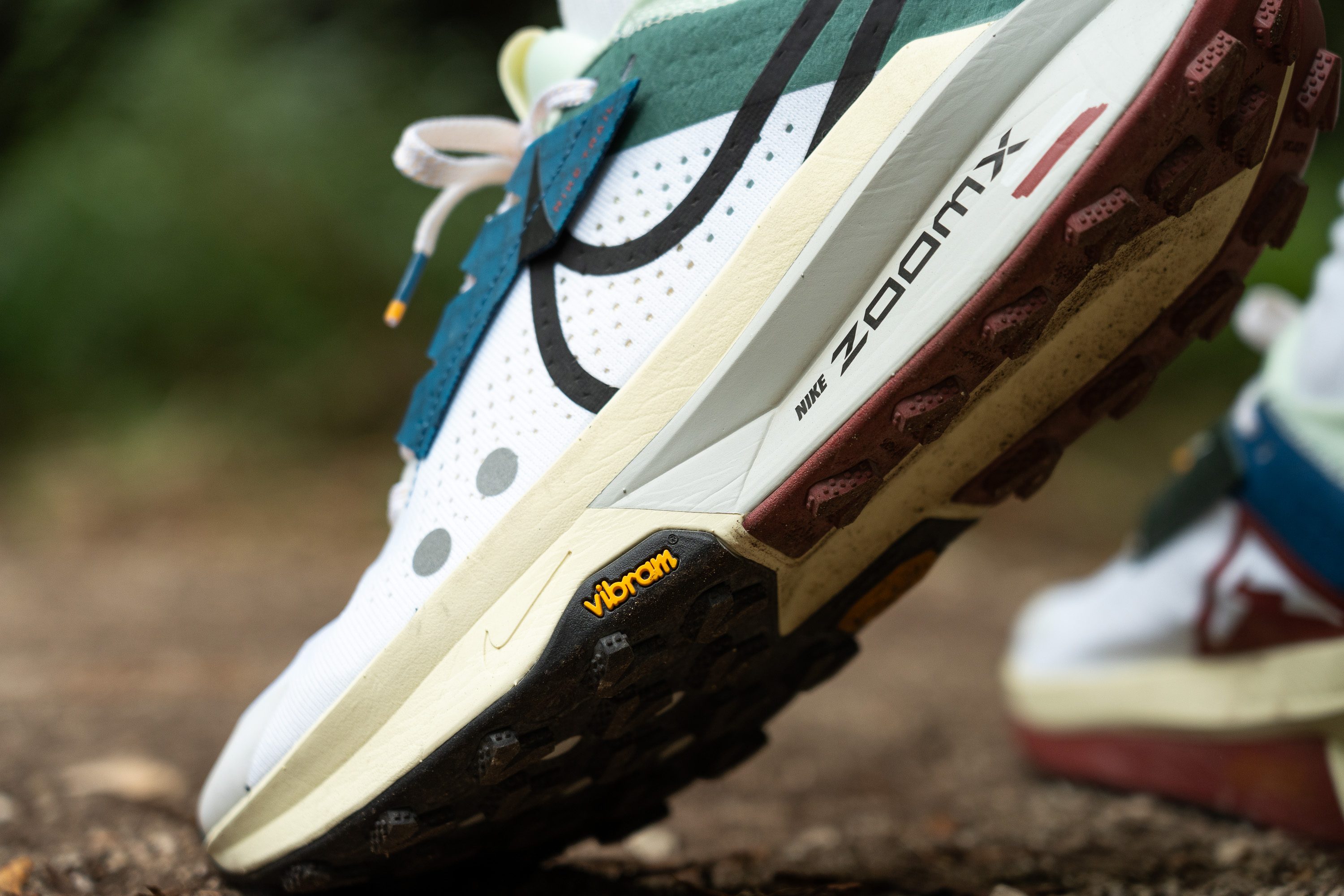
We discovered that the traction is excellent in both wet and dry conditions, a significant improvement over the first-generation model. The improvement even more crucial because, after all, the shoe is named for Zegama in Spain, a trail-running paradise known for its frequent rain and typical muddy conditions.
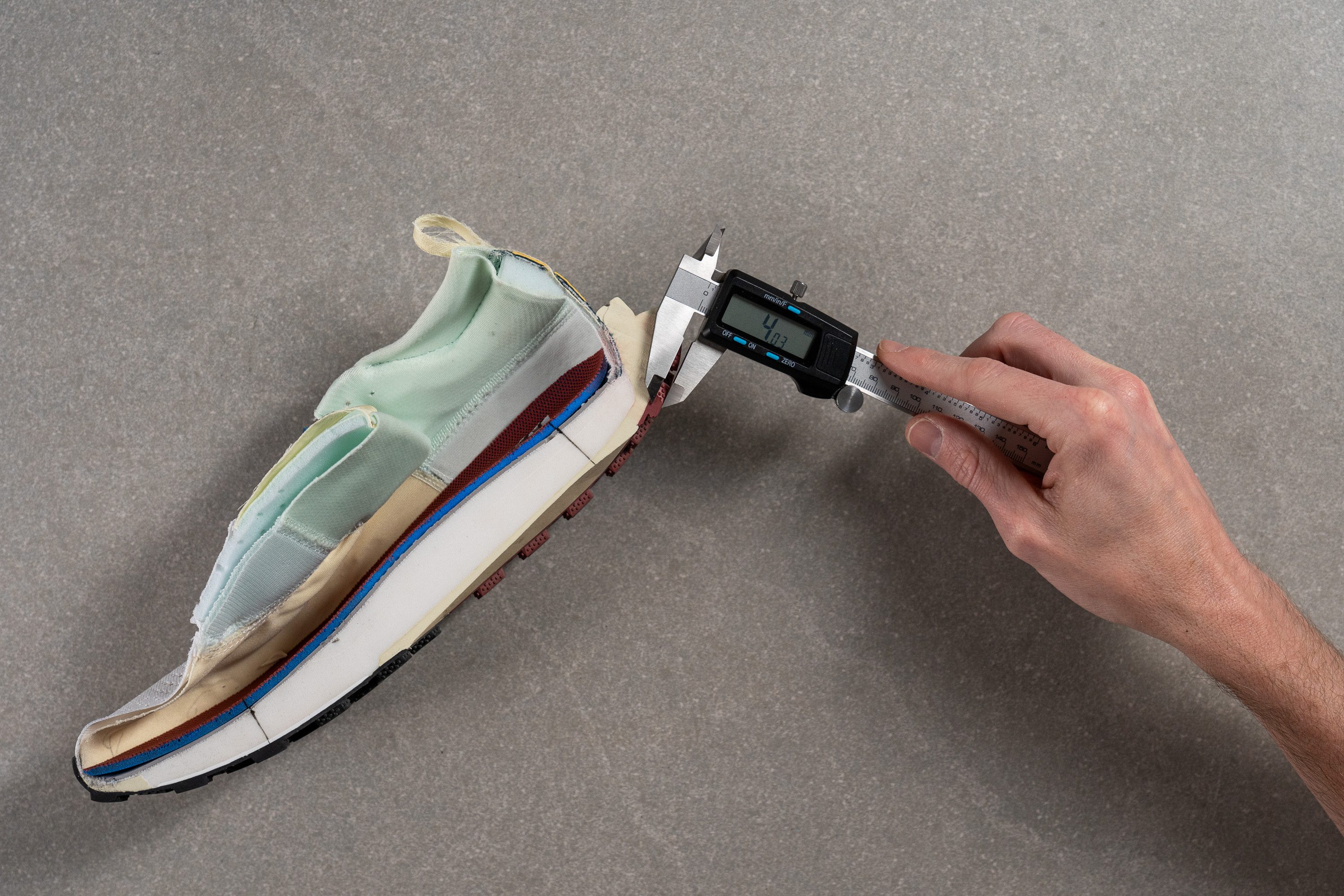
| Zegama 2 | 4.0 mm |
| Average | 3.5 mm |
Outsole design
The Zegama 2’s outsole uses a three-colour layout with partial coverage of Vibram rubber and large areas of exposed foam. The forefoot lugs are heart-shaped and moderately spaced, promoting flexibility through the curved flex grooves that split the rubber. In the midfoot, there's a large foam window surrounded by angled cutouts designed to reduce stiffness while trimming weight.
Toward the heel, the outsole features arrowhead-shaped lugs pointing opposite to the direction of travel, helping with braking on descents. We also spotted a small cutout right below the heel’s centre, where rubber coverage is, again, quite low.
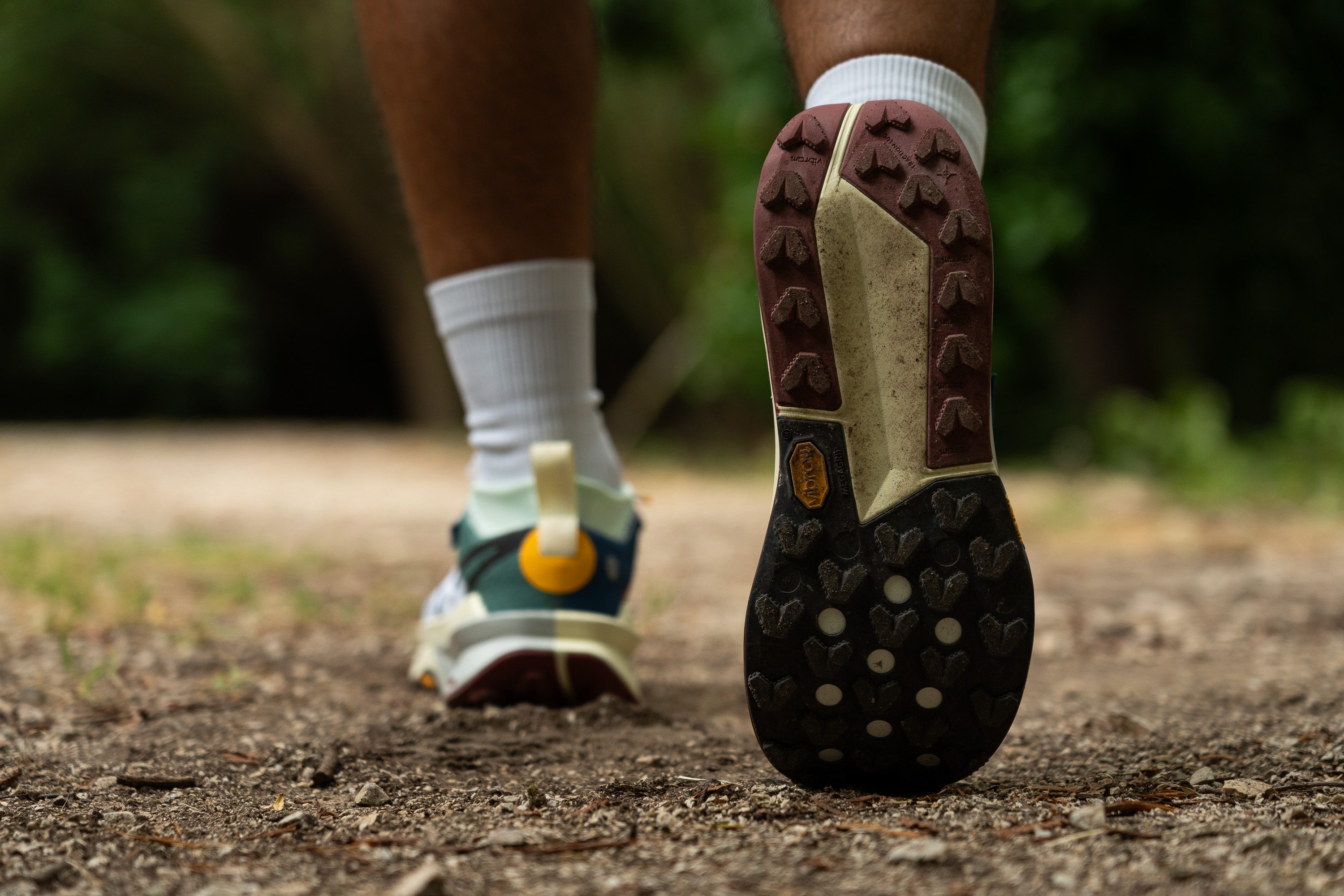
Flexibility / Stiffness
Despite its significant torsional rigidity, the Zegama 2 displayed remarkable flexibility lengthwise in our 30-degree bend test, requiring just 11.3N of force. This flexibility enhances comfort significantly, making it an excellent choice for hiking as well, even with its ample cushioning.

| Zegama 2 | 11.3N |
| Average | 14.7N |
Stiffness in cold (%)
Following a second 20-minute exposure to freezing conditions, we reevaluated the flexibility of the Zegama 2 and were impressed with the results. It exhibited only a 28.1% increase in stiffness, demonstrating its robust performance in cold weather!
| Zegama 2 | 28% |
| Average | 32% |
Weight
The Nike Zegama 2 is certainly not built for speed, nor does it fit the bill as a lightweight trail running shoe. Weighing in at a hefty 10.7 oz or 302g, it's considerably heavier than many competitors, making it less ideal for quick runs and better suited for easy or long runs.
In fact, we believe Nike needs to streamline the design of the next upper—it appears overly complex with excessive materials. Simplifying it could help reduce the weight to under 10 ounces.
However, it's worth mentioning that it could occassionally handle faster paces and random surges thanks to its responsive ZoomX foam, a feature we will explore in a minute.
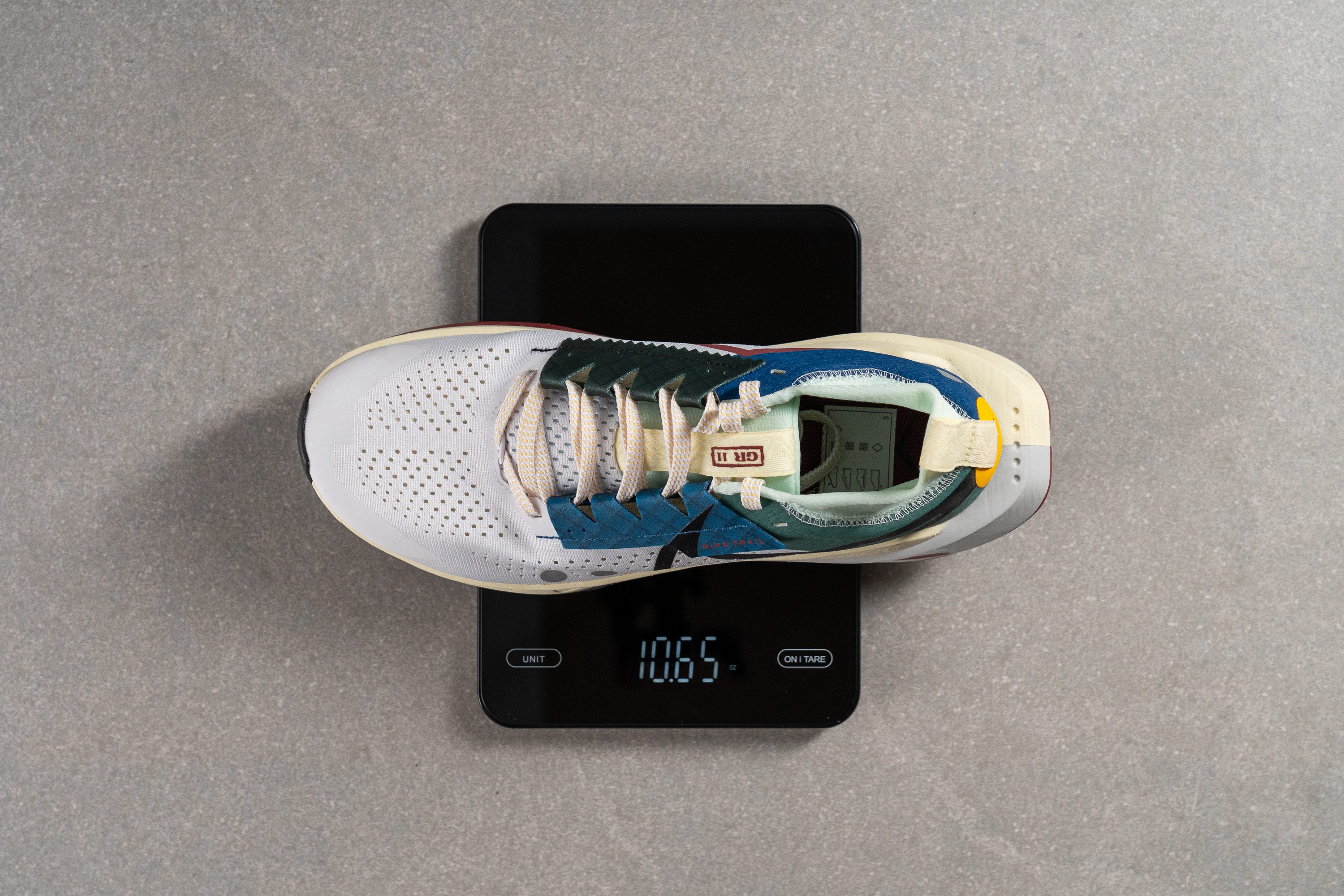
| Zegama 2 | 10.7 oz (302g) |
| Average | 10.2 oz (289g) |
Breathability
With dozens of ventilation holes, the Zegama 2 appeared to be highly breathable at first glance here in the lab. However, we often uncover discrepancies between initial appearances and actual performance—which is exactly why we rigorously test running shoes in our lab.
Using a smoke-pumping machine connected to our custom 3D foot model to simulate airflow in the toebox, the Zegama 2 simply delivered. We rated its breathability 4 out of 5, making it ideal for trail running in summer yet also suitable for cooler weather.
Our examination with the light revealed that Nike designed the Zegama 2’s upper with thin material in the toebox and midfoot to enhance airflow, which may raise some durability questions, but we'll address that later.
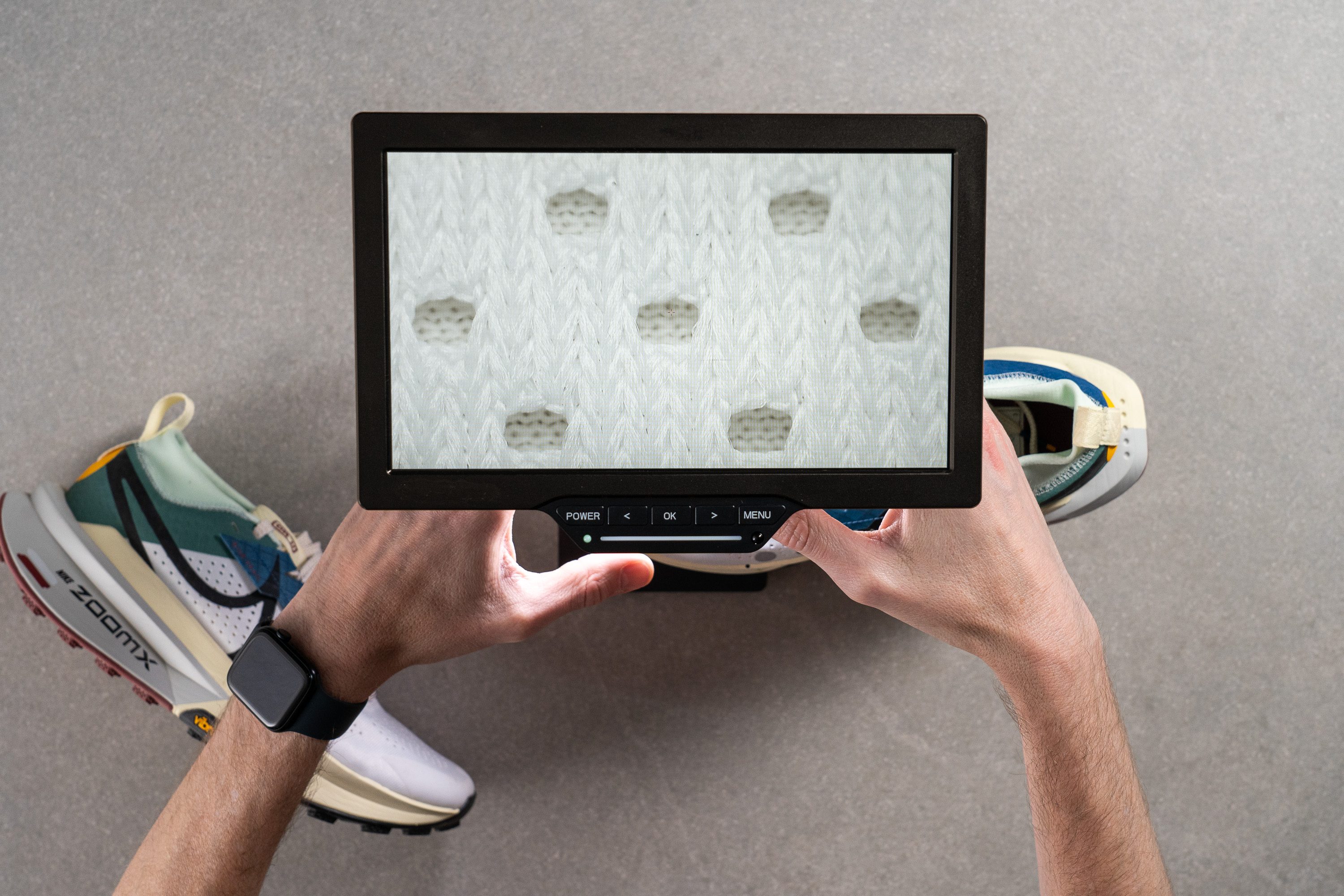
First, we need to examine the engineered mesh upper under our microscope to observe its structure closely.

There, we discovered a robust mesh with numerous ventilation holes, paired with an underlayer for added durability and comfort. This material appears well-structured, and we anticipate it will hold up well.
Finally, exploring the upper with our hands, we found it exceptionally padded in the midfoot and heel for comfort, and the mesh is notably non-stretchy. We think this is a good upper!
| Zegama 2 | 4 |
| Average | 3.2 |
Stability
Lateral stability test
The Zegama 2, with its plush foam and relatively high stack height, is not ideal for those needing extra stability. We believe it's best suited for neutral runners.
Yet, this doesn’t imply it lacks stability entirely. Thanks to its raised sidewalls and lateral reinforcements, the supportive carrier foam, and the effective rocker design, we found it provides sufficient stability for easy to moderate trails.
Torsional rigidity
One feature that indicates Nike's focus on improving stability is the torsional rigidity of the shoe. In our manual testing here in the lab, we rated it a solid 4 out of 5, which is high for a shoe with just over 30 mm of stack height and no plate.
| Zegama 2 | 4 |
| Average | 3.6 |
Heel counter stiffness
On the downside, the heel counter is notably flexible (2/5), which is extremely comfortable but might not offer the best support for heel strikers. Combined with the 4-mm drop, this might make the shoe less suitable for those who primarily land on their rearfoot.
If that describes you, a shoe like the Brooks Caldera 7 could be a better choice.
| Zegama 2 | 2 |
| Average | 3 |
Midsole width - forefoot
Despite its behemoth-like large appearance at first sight, the Zegama 2 actually has an average width. We measured 114.9 mm in the forefoot, which is quite close to the average for trail shoes.
Why not opt for a wider design like many similar shoes? We believe it boils down to weight considerations. The Zegama 2 is already on the heavier side, and increasing its width could potentially add too much weight.
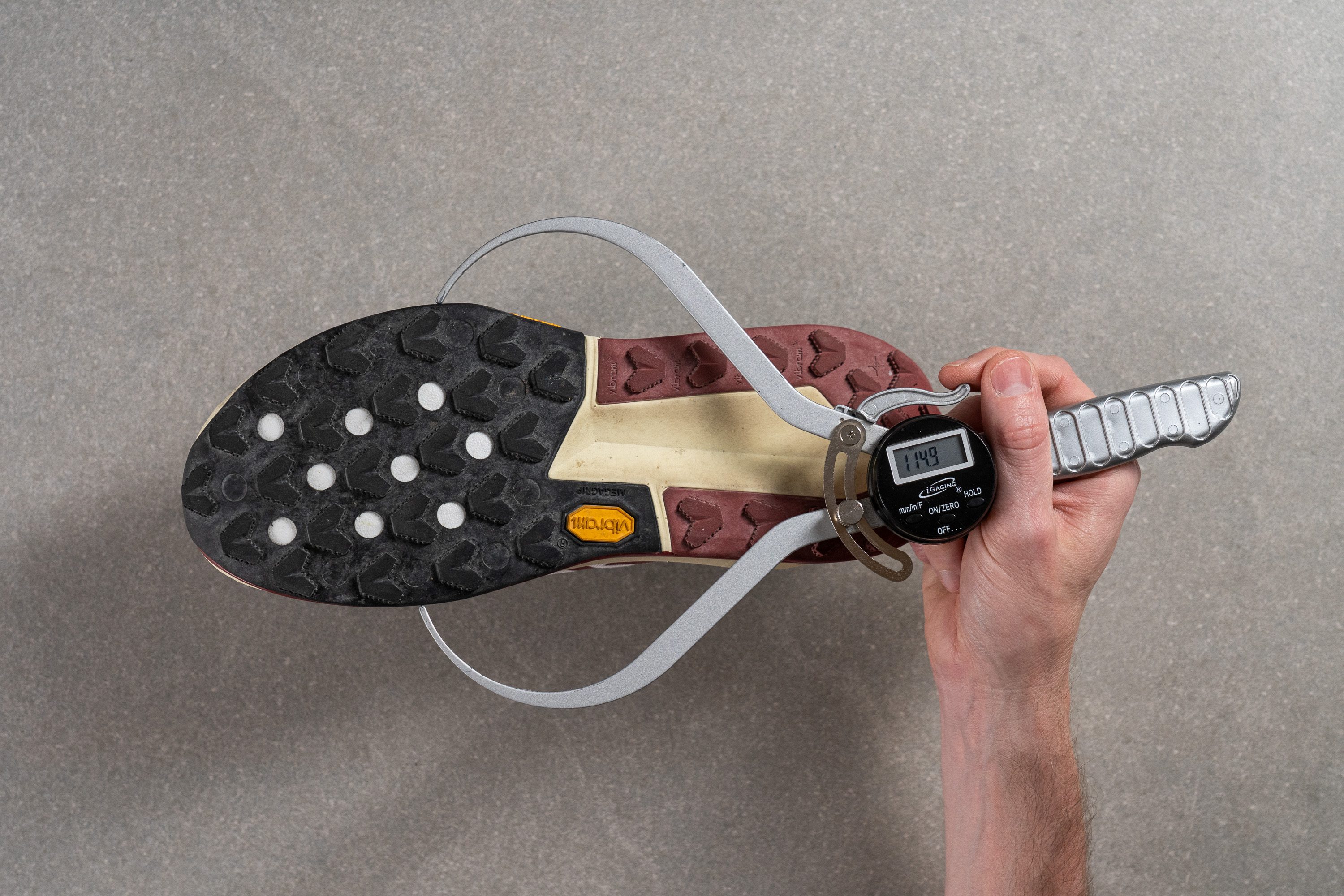
| Zegama 2 | 114.9 mm |
| Average | 112.8 mm |
Midsole width - heel
The heel measures 94.4 mm in width. With its plush foam and soft heel counter, this design at least offers some of the much-needed stability!
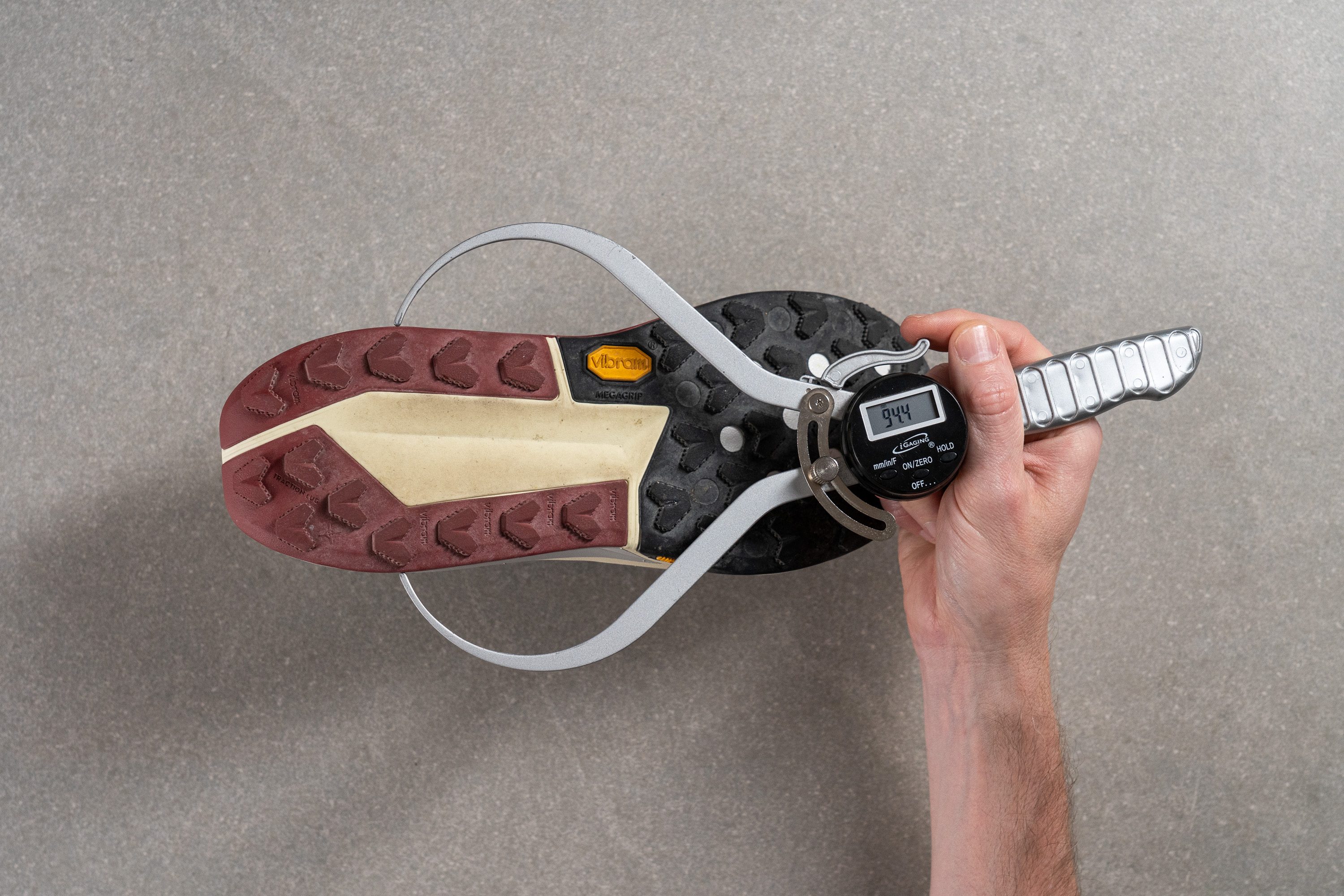
| Zegama 2 | 94.4 mm |
| Average | 89.9 mm |
Durability
Toebox durability
The toebox truly justifies its premium price tag, offering exceptional comfort and ventilation. And we also found that its durability exceeded our expectations.
We discovered that Nike combined a robust upper with a thin TPU protective layer, enabling the Zegama 2 to score a fantastic 4/5 in our rigorous testing.
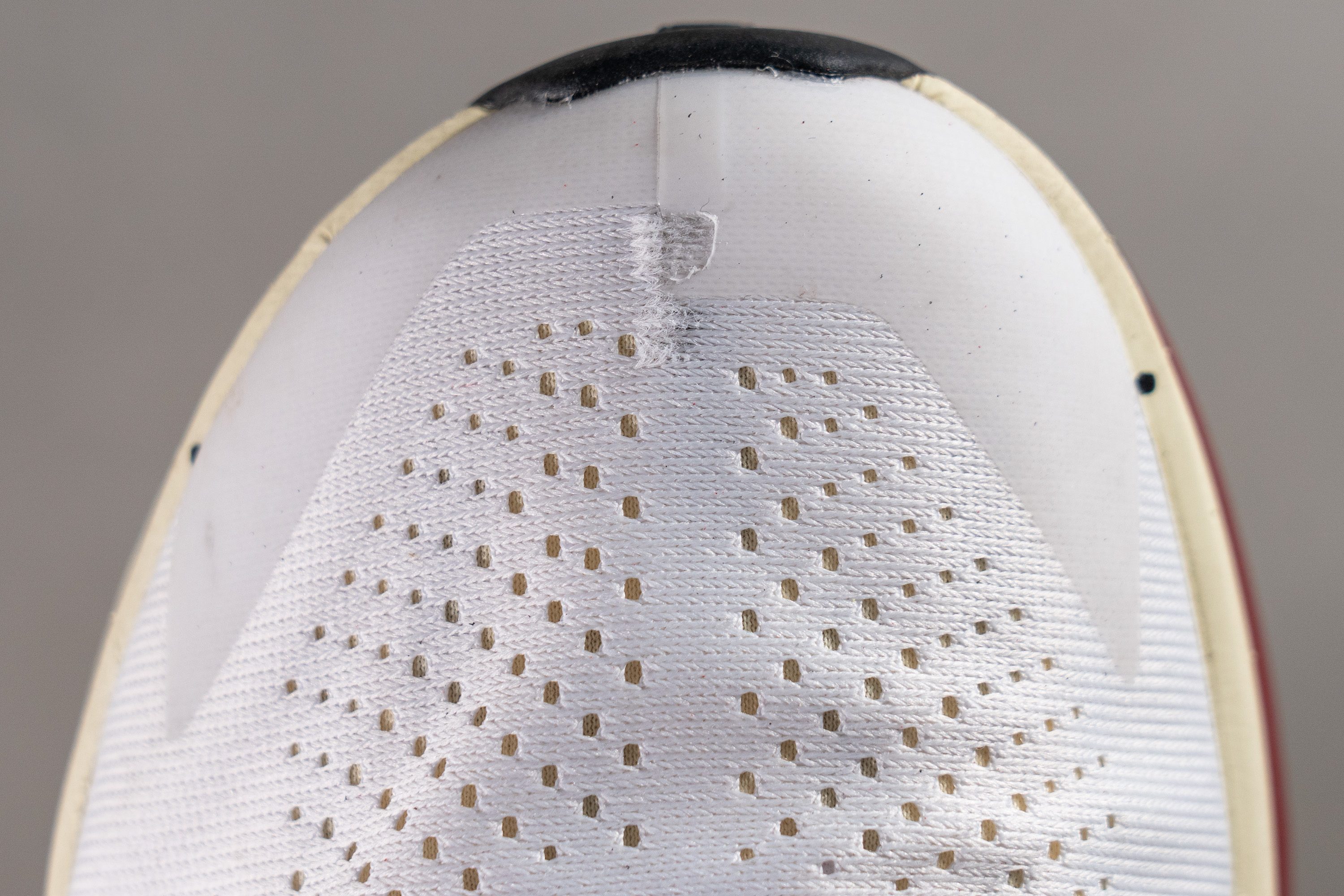
| Zegama 2 | 4 |
| Average | 3.1 |
Heel padding durability
And things just keep getting better. After a solid performance in the toebox testing, we moved our Dremel to the heel padding and awarded a perfect 5-out-of-5 score. Outstanding!
We still need to evaluate the outsole, but given it's from Vibram, there's a strong likelihood that the Zegama 2 could excel in all our durability tests—a rare feat in our lab.
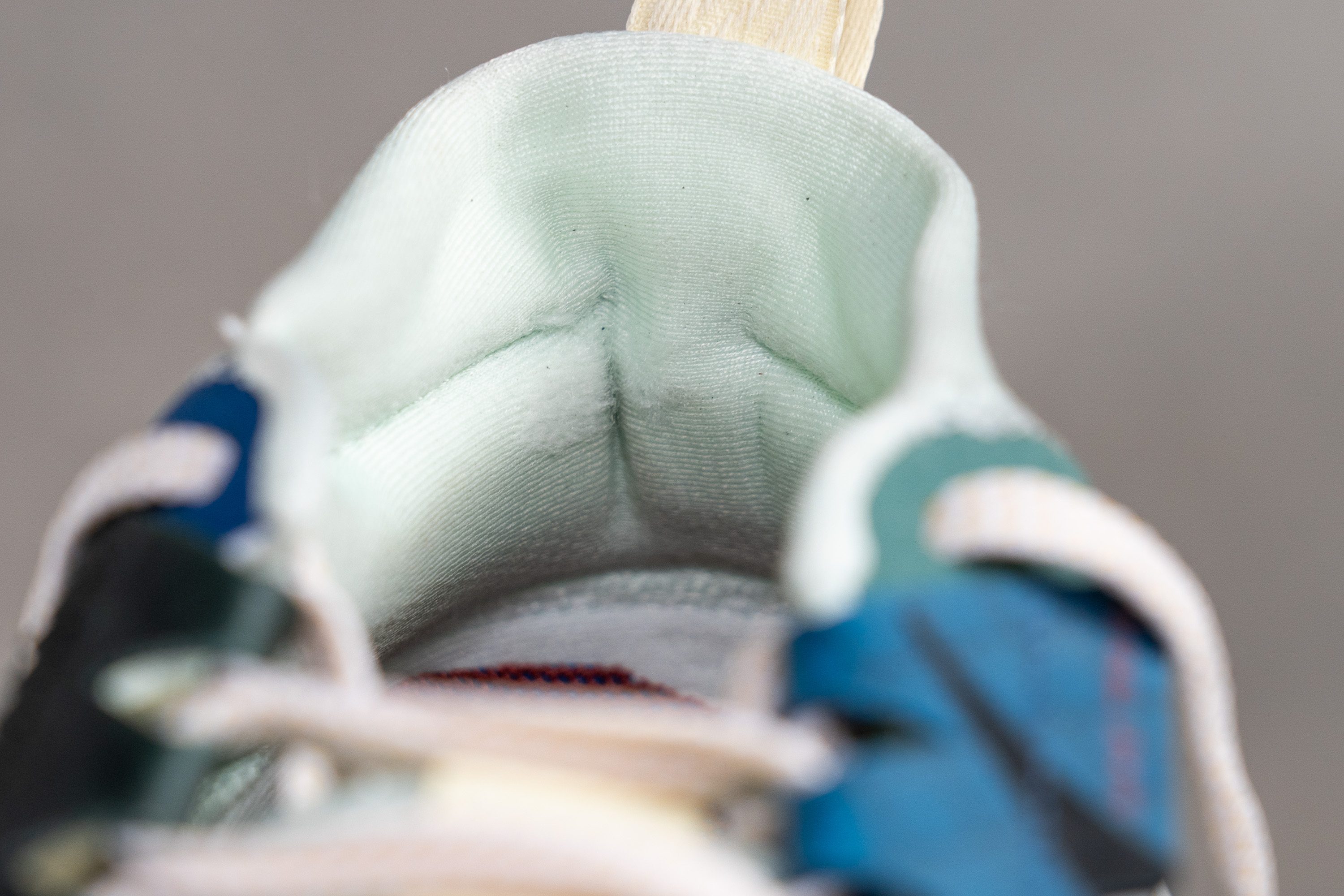
| Zegama 2 | 5 |
| Average | 3 |
Outsole hardness
Now it's time for our third Dremel test. The outsole represents arguably the most significant upgrade from the previous Zegama, which lacked grip especially in wet conditions.
What we discovered is a perfectly balanced compound in terms of hardness at 85.5 HC, exactly what we anticipated from the renowned Vibram Megagrip.
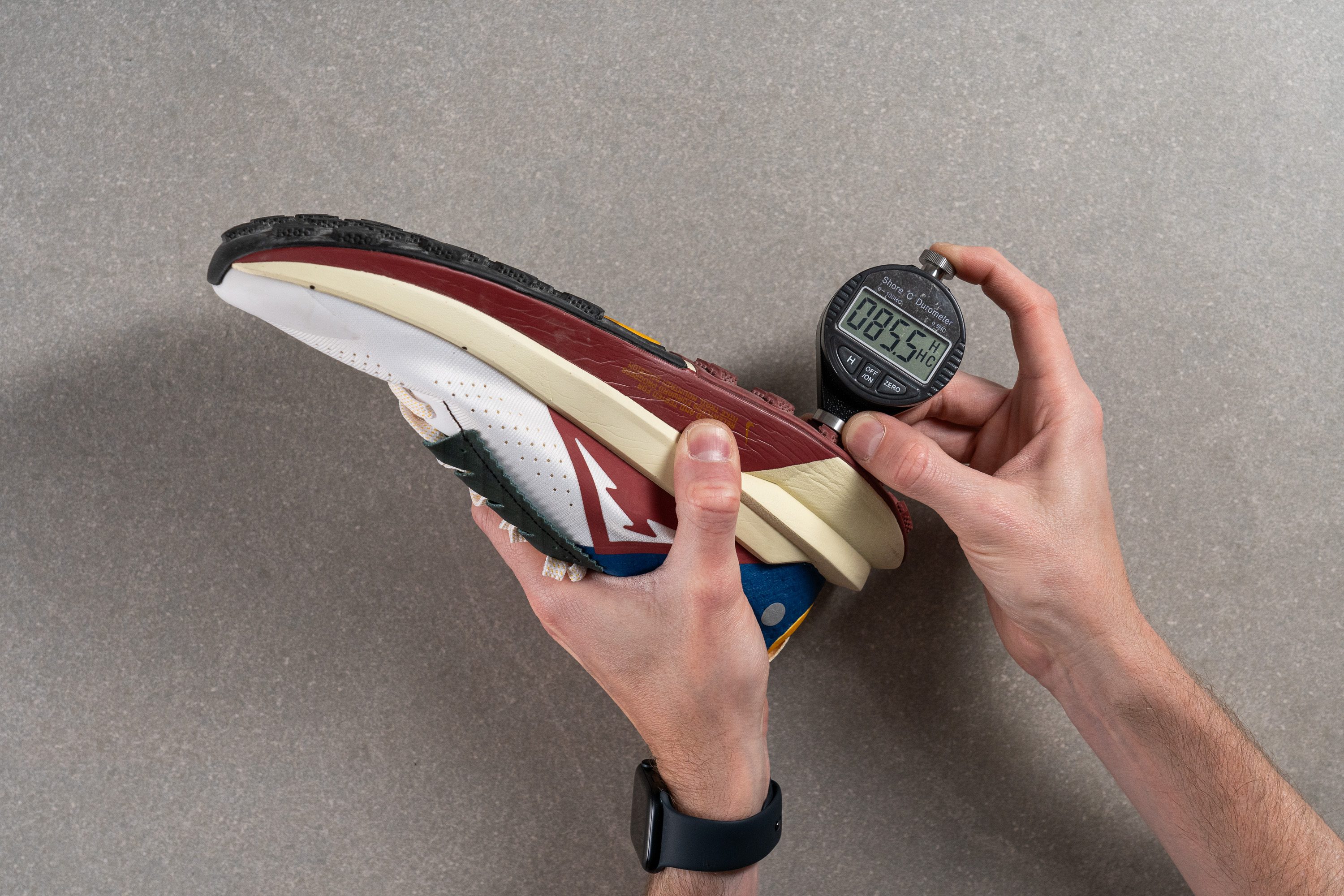
| Zegama 2 | 85.5 HC |
| Average | 85.8 HC |
Outsole durability
We all recognise that Vibram Megagrip is among the top outsole compounds on the market for grip—hence its name—but how does it fare in terms of durability? Once again, our Dremel came into play to test this.
After completing our rigorous testing, we observed only a minor 0.8 mm dent, a very encouraging result that clears up any concerns about the wear and tear on the Zegama 2. We are extremely pleased with this result!
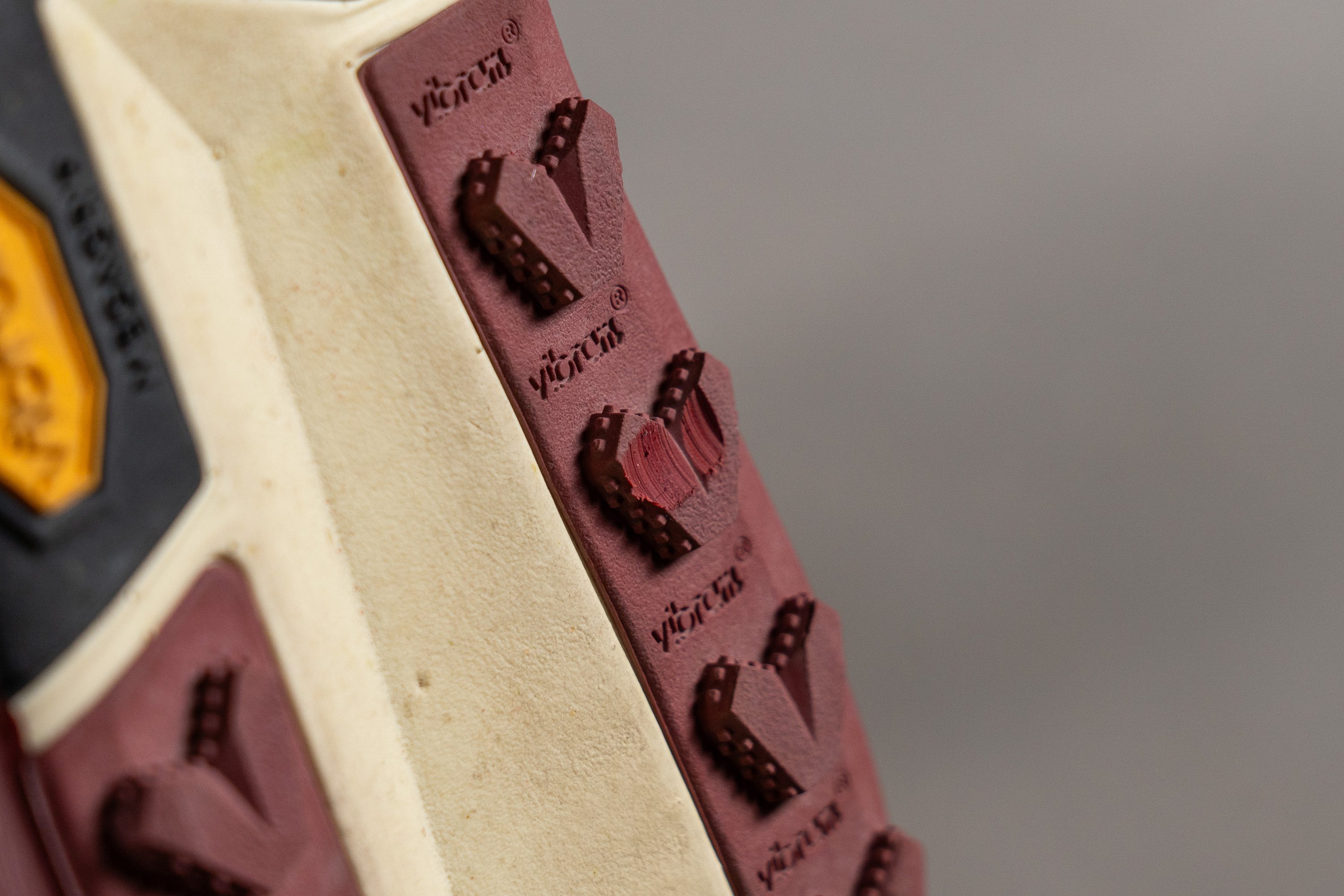
| Zegama 2 | 0.8 mm |
| Average | 0.9 mm |
Outsole thickness
We also looked into the thickness of the Vibram rubber (we'll check the lugs later,) finding it to be an average 2.0 mm—quite typical for versatile trail shoes.

| Zegama 2 | 2.0 mm |
| Average | 2.2 mm |
Misc
Insole thickness
We discovered the insole to be slightly thinner than usual in other Nike shoes at just 3.9 mm.
Do we like this? Absolutely, especially if it means that for the same stack height, there's more ZoomX foam and less EVA insole—a definite plus in our books.
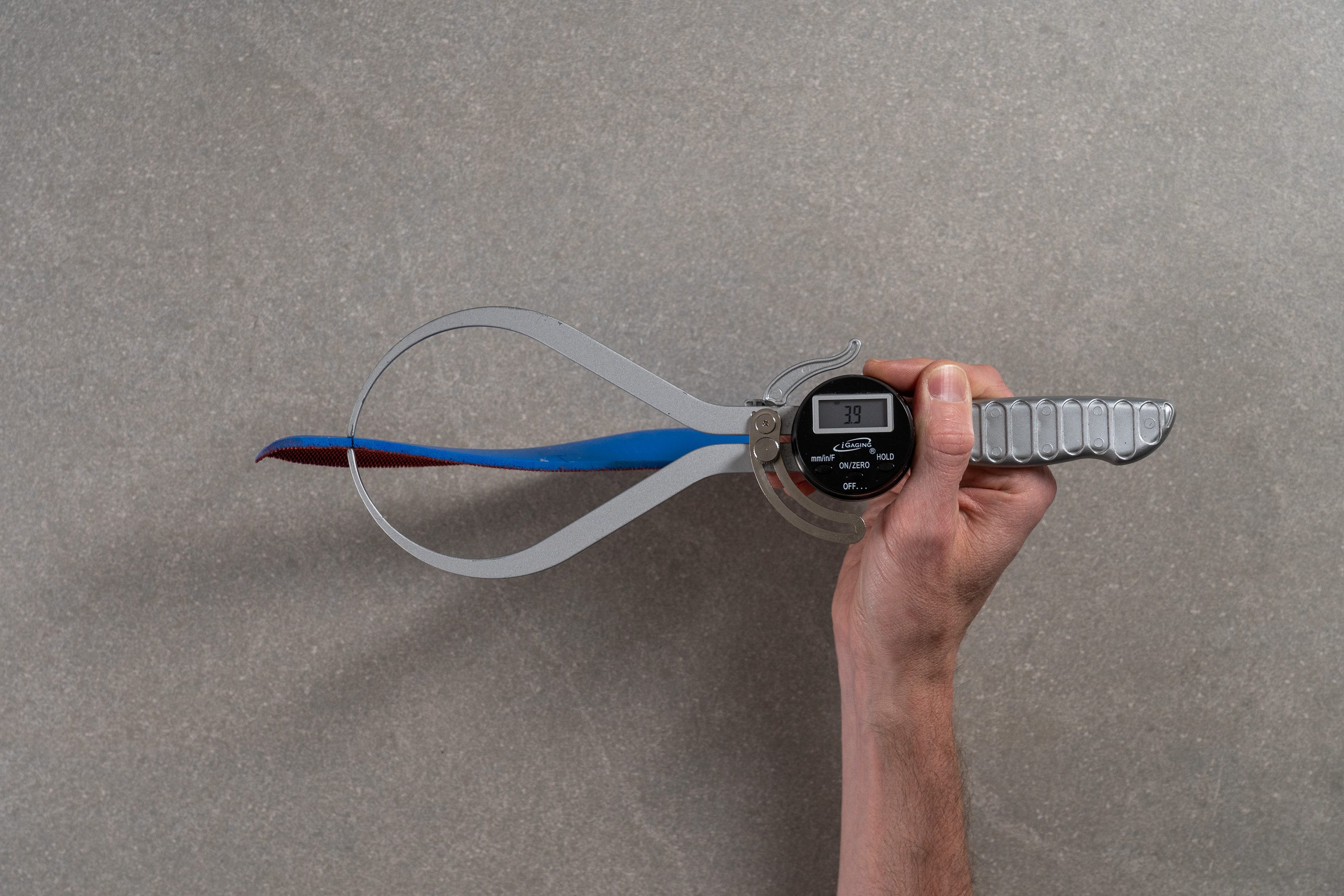
| Zegama 2 | 3.9 mm |
| Average | 4.7 mm |
Removable insole
We like that Nike accommodates those who opt for other insoles with their design. Our tests showed that you can easily remove the original footbed without any issues.

| Zegama 2 | Yes |
Midsole softness in cold
Our second measurement, taken in the big toe area, confirmed the toebox's generous width at 81.6 mm.
However, we also discovered that the vertical space in the toebox is somewhat limited like in the first-gen Zegama, which might feel restrictive for runners who point their toes upward while running or those with particularly large feet overall. We believe this won't pose an issue for most, though.
| Zegama 2 | 15.9 HA |
| Average | 27.4 HA |
Midsole softness in cold (%)
The Zegama 2 is a trail shoe designed for year-round use, and we're sure many trail runners likely aim to wear it throughout all seasons. Impressively, after freezing it for 20 minutes, we discovered that the midsole only became 9.5% firmer. This performance is truly remarkable!
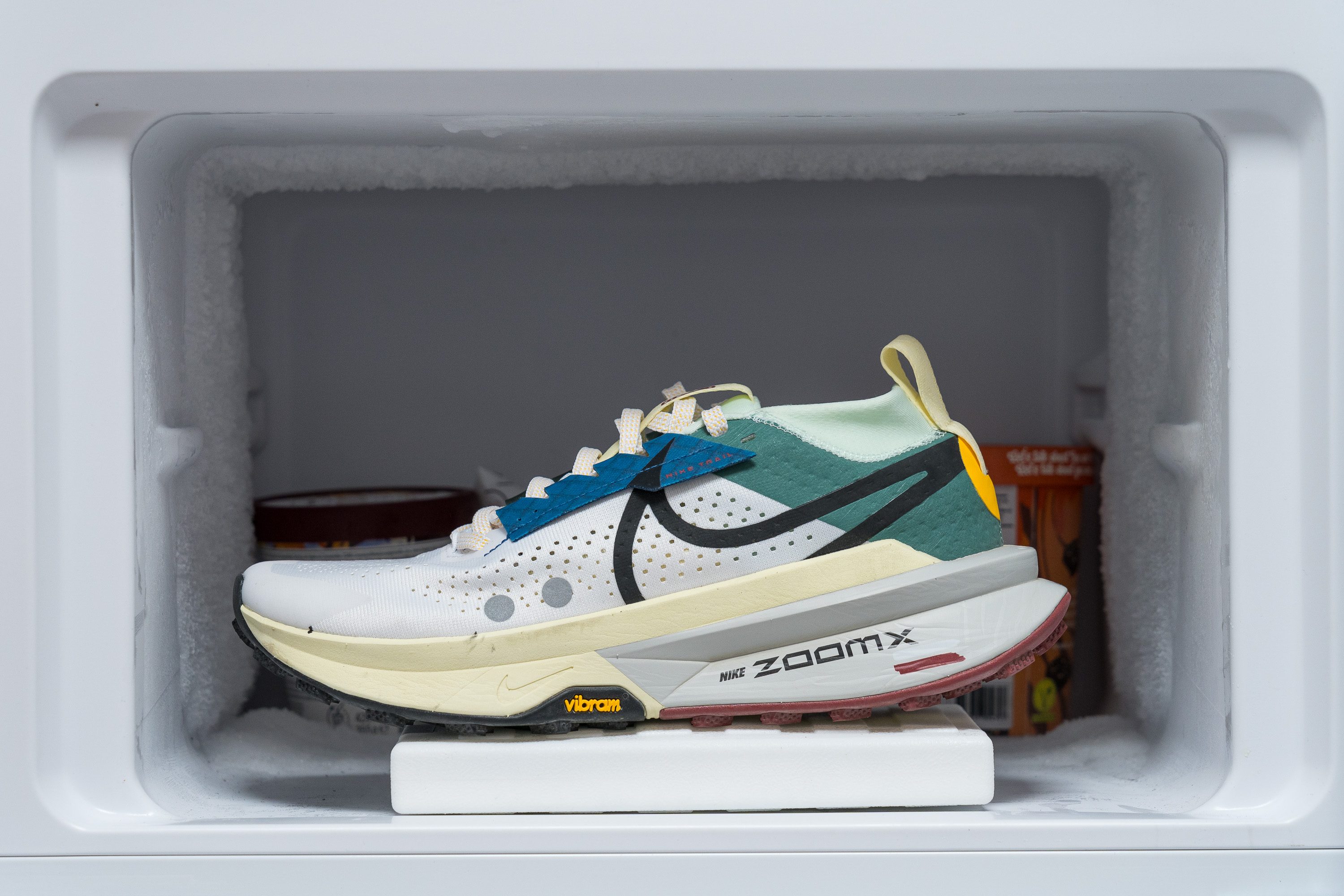
| Zegama 2 | 10% |
| Average | 26% |
Reflective elements
A proper trail running shoe should have reflective features for safety, and we found that the Zegama 2 includes them. However, they are quite basic—just two small dots!
| Zegama 2 | Yes |
Tongue padding
We really liked the tongue on this shoe—it strikes a perfect balance with enough cushioning (6.0 mm featuring a single slab of foam) for comfort during long hours of wear, yet it remains lightweight and doesn't add much bulk to the shoe.

On the contrary, the lacing system features only a few punched eyelets, and could make achieving the perfect fit slightly challenging in our view. On the other hand, while the laces are good enough, they aren't premium by any means—unlike the shoe's £180 price tag.
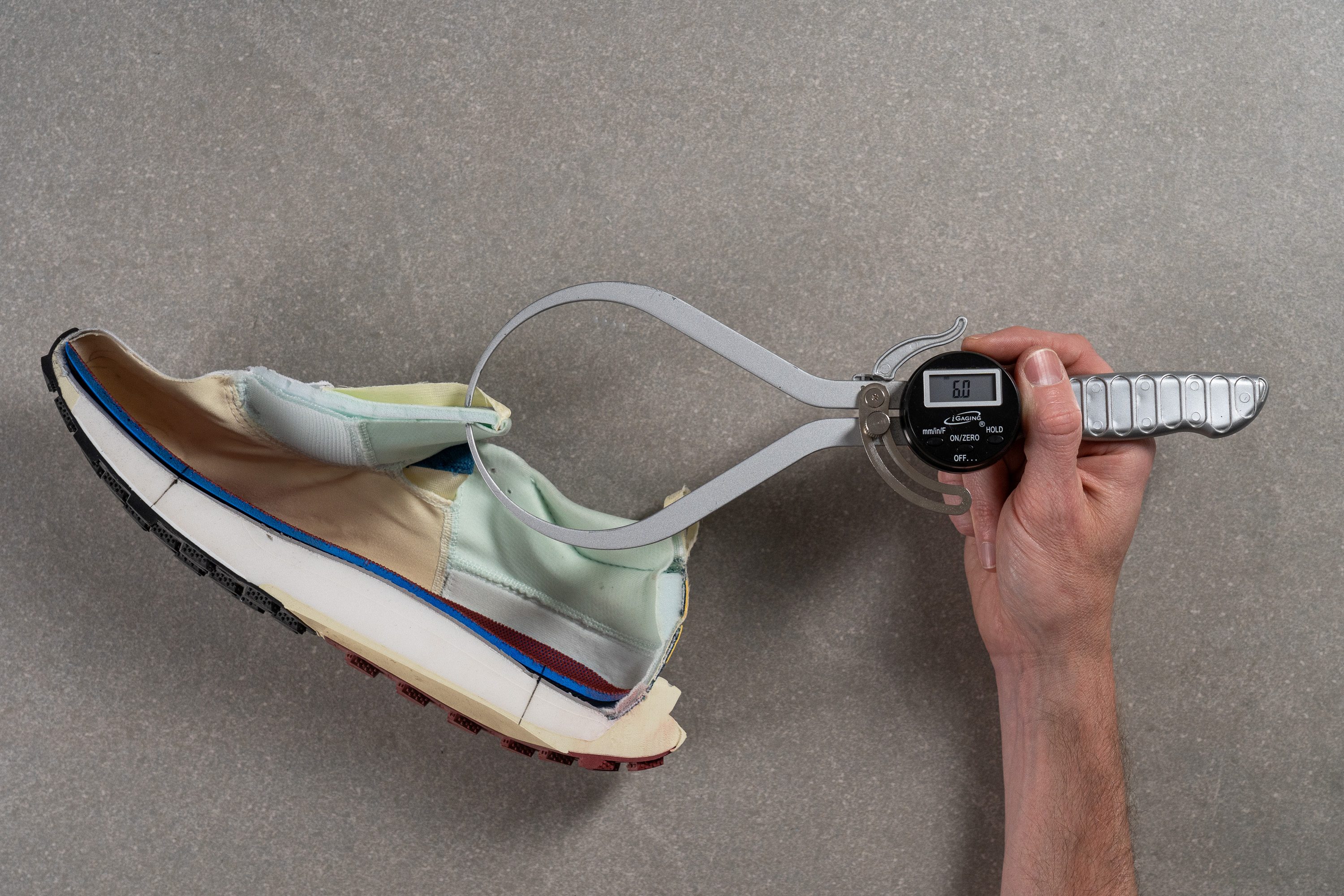
| Zegama 2 | 6.0 mm |
| Average | 6.4 mm |
Tongue: gusset type
A gusseted tongue is highly desirable in every trail shoe, but unfortunately, some models like the NB Fresh Foam X Hierro v8 lack this feature, which is disappointing. However, the Zegama 2 includes a fully gusseted tongue, and it's a fantastic addition because it effectively prevents debris from entering the toebox.
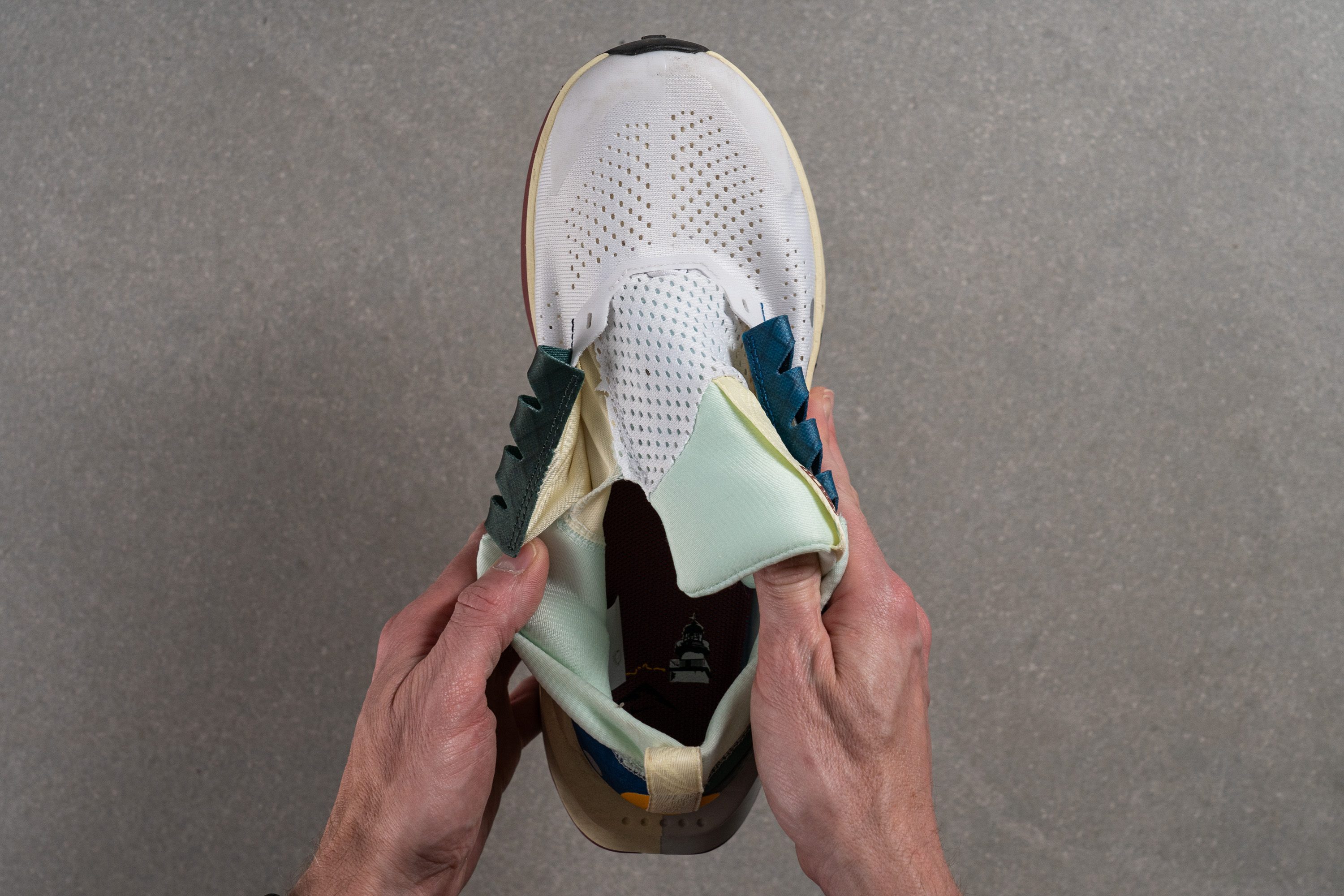
| Zegama 2 | Both sides (full) |
Heel tab
The Zegama 2 once again features a handy finger-loop heel tab—a feature carried over from its predecessor that we truly appreciate and hope will continue in future versions.
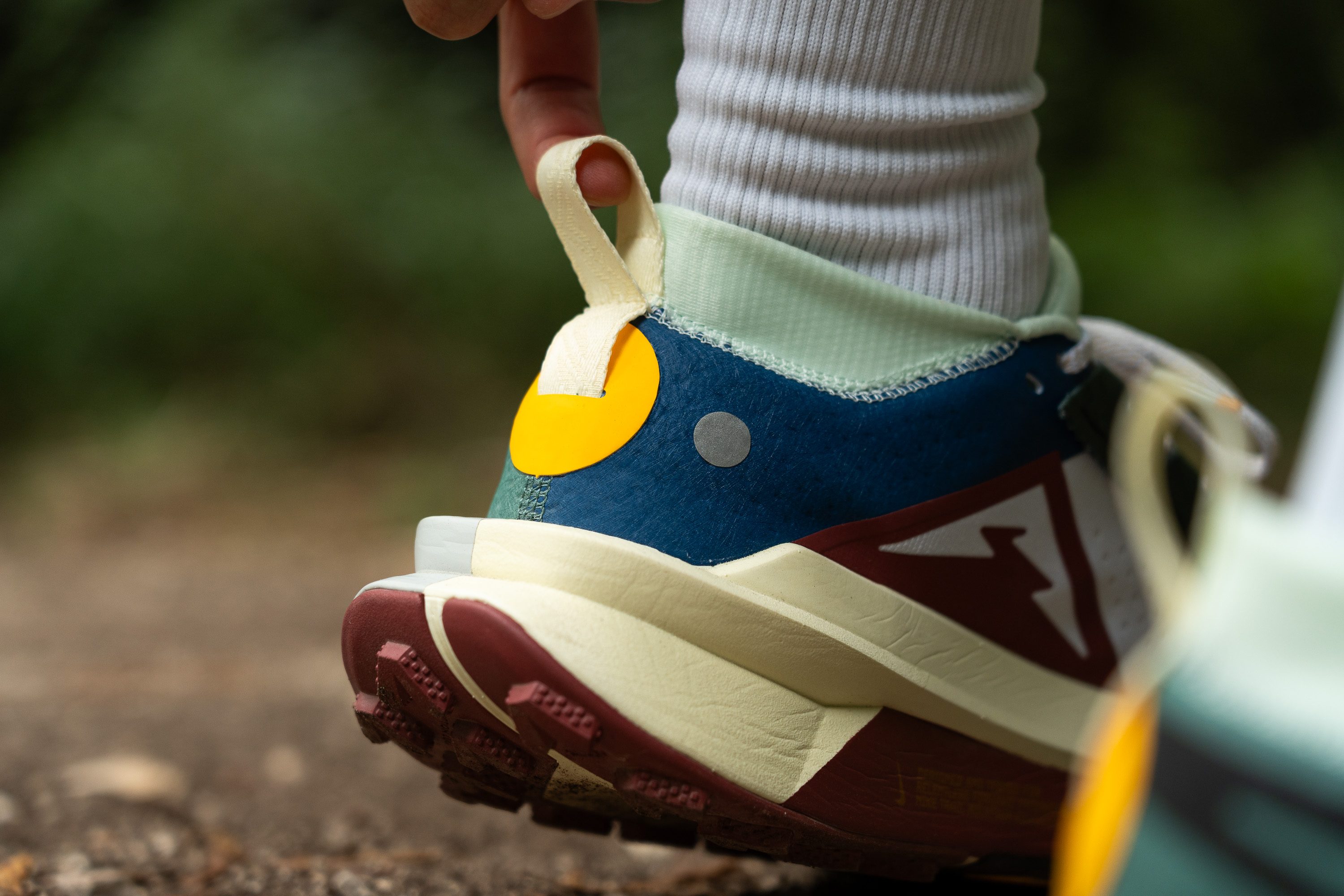
| Zegama 2 | Finger loop |

